SEPARATING THE NEXTS FROM THE NOW: A LUXURY MOTORCYCLE TOUR IN SPAIN
When you buy something using the links on our site, we may earn a small commission, which does not increase your price. Gentleman Biker does not accept money for editorial reviews. Read more about our policy.
- by T.E. Whitaker
The Tour's Table of Contents
ARRIVAL
A bit feverish with the travel bug a month ago, I’d asked myself where in the world was warm in late November? Did any of those places possess a good number of high-end restaurants? Of those, were any motorcycle-friendly and without threat of quarantine upon arrival? Spain rose to the top of a short list.
But it wasn’t all that warm, and the rain continued. Had I made a mistake?
“I’ll meet you in Barcelona,” agreed a London-based friend, business partner, and travel blogger. Eddie had encyclopedic wine knowledge and was more critical than me when it came to food—he gave no quarter to anything less than the best and raised his bar of acceptability if a restaurant dared hang Michelin stars on its door—though he couldn’t touch my espresso snobbery or my not-yet-renowned WDPR (Worldwide Dessert Power Rankings).
I made the arrangements and arrived in Spain just in time for a bright, sunny weekend in Barcelona. I met Eddie at his hotel and we took a cab to Gaudi’s Sagrada Familia, the towering unfinished basilica that served as the world’s mental image of Barcelona.
“The word on the street is they’ll never finish it,” Eddie said as we stood with the masses, gaping at the basilica’s fantastical towers and colors.
“Maybe being unfinished is part of its charm.”
“They lost the original plans in a fire during the Spanish civil war,” he said. “They reverse-engineered his intent based on geometry.”
We hoofed it through Barcelona, seeing the sights because this was my first visit to Barcelona, and happened upon an outdoor electric vehicle expo where we explored the “if we gave you cash right now” price of an oversized electric go-kart that struck me as something I could ship around the world and run the Singapore F1 street circuit in the dead of the night.
“No one will visit you in jail in Singapore,” Eddie said.
My nascent dream squashed, we moved on, our destination a renowned tapas bar in a city of tapas bars.

POSERS MOTORCYCLE CLUB
Bar Cañete is a narrow, boisterous place, with a long, glass-encased tapas bar, a small, frenetic open kitchen, and a waitstaff that seems to enjoy working late together. The Cañete team weaves and sings behind the bar with not quite music video-level choreography. Our man broke into song—to his chagrin I sang along—and took our broken-Spanish order efficiently, with good-humored indulgence.
“I love this place.”
“Their wine selection is good here,” Eddie said, “if you know what to get.”
The food began to arrive. Hand-cut cured bellota cured ham and toasted flatbread with tomato, which would become staples of my time in Spain. Aged beef steak tartare with crispy french fries. The jamón melted in my mouth, the tomato bread and olive oil delivered a satisfying crisp, the beef tartare conjured a time before fire, and—
“If we passed out leather jackets we’d have a biker bar,” I said, “with really sophisticated pizza and burgers and fries.”
“I’m not sure you’d find enough Harley riders in the city to make a go of it.”
I glanced out the front window at the line of scooters parked across the alley. “What do rebel Vespa riders wear?”
“Sneakers and street clothes, same as everyone else. Motorbikes aren’t a subculture here. They are the culture.”
“Then there’s room for a Posers MC chapter here.”
“What’s Posers MC?”
“My mental motorcycle gang. Successful riders who like pretending we’re badass bikers on the weekends. You know, guys who grunge up on their forty-thousand-dollar Harley, or their Ducati Superleggera, or their six-figure Arch.”
Eddie laughed. “You can’t ride around Barcelona on a Road King. The scooter spaces are too small.”
“Maybe a Monster, or a Triumph.”
“You adapt to Barcelona,” he said. “It doesn’t adapt to you.”
“I could nudge it a little.”
“Not how it works.”
Our waiter passed, belting out “Don’t Stop Believin’,” which played throughout the tapas bar.
“Sounds like Barcelona adapts to Journey,” I said.
“They’re the exception.”
The night wore on, we ate, our waiter looked displeased whenever I dared join him in song—this was his stage—and the dessert arrived.
Torrijas Sweet Wine at Bar Cañete is, like many transcendent dishes, simple. It’s french toast, dipped in sweet wine and/or milk, fried crispy on the outside, spongy and soaked on the inside, served with a side of vanilla ice cream and swirls of cream. Sweet but not too, crispy but perfect, moist but firm, hot, cold—a study in taste and textural contrasts.
“This is ridiculously good.”
“A little precious for Harley riders, isn’t it?” Eddie asked, openly mocking my vision of my Road King’s rumble echoing through Barcelona’s alleys.
I savored the last bite and set down the spoon. “They’ll adapt.”
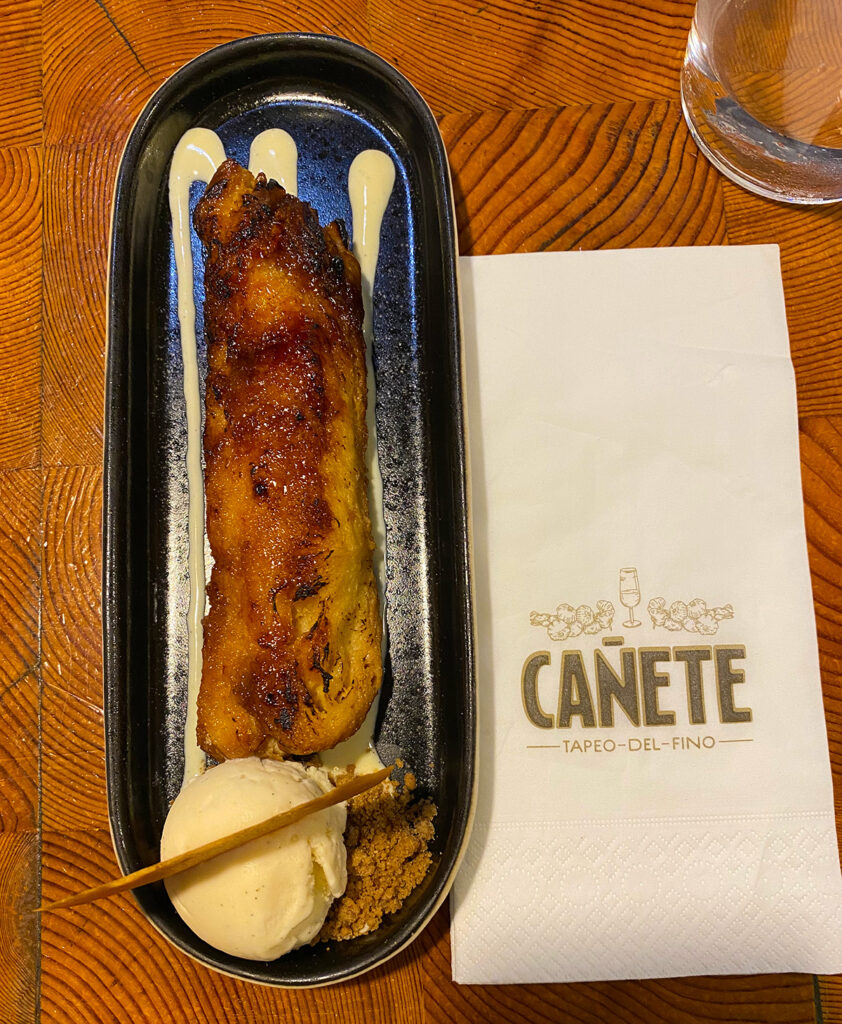
RAINY ROAD TO VALENCIA
The sunny weather held until the day I rented the BMW for the ride down the Mediterranean coast to Valencia.
Though my route from Barcelona to Valencia cut nowhere near the Spanish plains, the rain had been falling for an hour. The big BMW 1250RT’s fairing cut through the rain and truck spray, keeping me relatively dry, which was why—along with a little blind hope the rain would soon stop—I’d waited until now to stop beneath an overpass and pull on the rain pants.
By giving in to the elements with the rain pants, when I started the bike I fulfilled the last remaining requirement of my application for full membership into Posers MC by turning on the handgrip and seat warmers. I rolled my eyes at myself.
“At what price comfort?” Euclid would ask were he there. “Your very biker’s soul?”
“Aye,” I replied miles later, as the grips’ and seat’s warmth enveloped me in positive vibes and—with the help of the fairing and rain pants and the amazing Alpinestars Andes Tourer adventure jacket I’d rented from the BMW rental shop—cocooned me in a dry, warm bubble at 110 kph in the rain and cold, “but one’s soul ’tis a small price to pay for this level of comfort.”
“Have you no shame?” he responded as the sky lightened far ahead, a real or fantasized hint of blue in the faraway clouds’ white. “Don’t humiliate your friends and family by telling everyone you used the seat warmer.”
“Too late, my friend.” I steeled myself for the mocking of the trolls. “It is done.”
Fifty miles later, I snaked along the Mediterranean beneath partly cloudy skies. Sun shafts struck the sea and spotlighted a hillside ruin of the sort one might have for a dollar in Italy—if you had the stomach for an overseas renovation and the blind trust to match.
Lunch consisted of jamon, bread, and olive oil by the sea somewhere near Tarragona. I watched the water, in no hurry given the darkened skies in Valencia’s direction, my only goal to make it to the hotel before nightfall so I could hunt for its garage elevator in daylight, for which I had vague directions that included the phrases “down an alley” and “limited spaces” and “not reserved” and “alternative parking lot a few blocks away.”
I walked back to the bike, traded my sea green sweater and black suede jacket for the Andes Tourer, and pointed the BMW toward Valencia. The sunshine held for thirty minutes, but the rain escorted me into the city. Three laps around the hotel later I found the garage elevator, courtesy of a Dutch couple returning their rented bicycles. I joined them in the oversized elevator, with the big touring bike consuming most of the space. They endured the American.
After securing the bike and checking in, I took a hot shower and dressed for a night out—again, the black jeans, green sweater, and black suede jacket I’d wear everywhere because it worked—and set off for Eddie’s hotel.
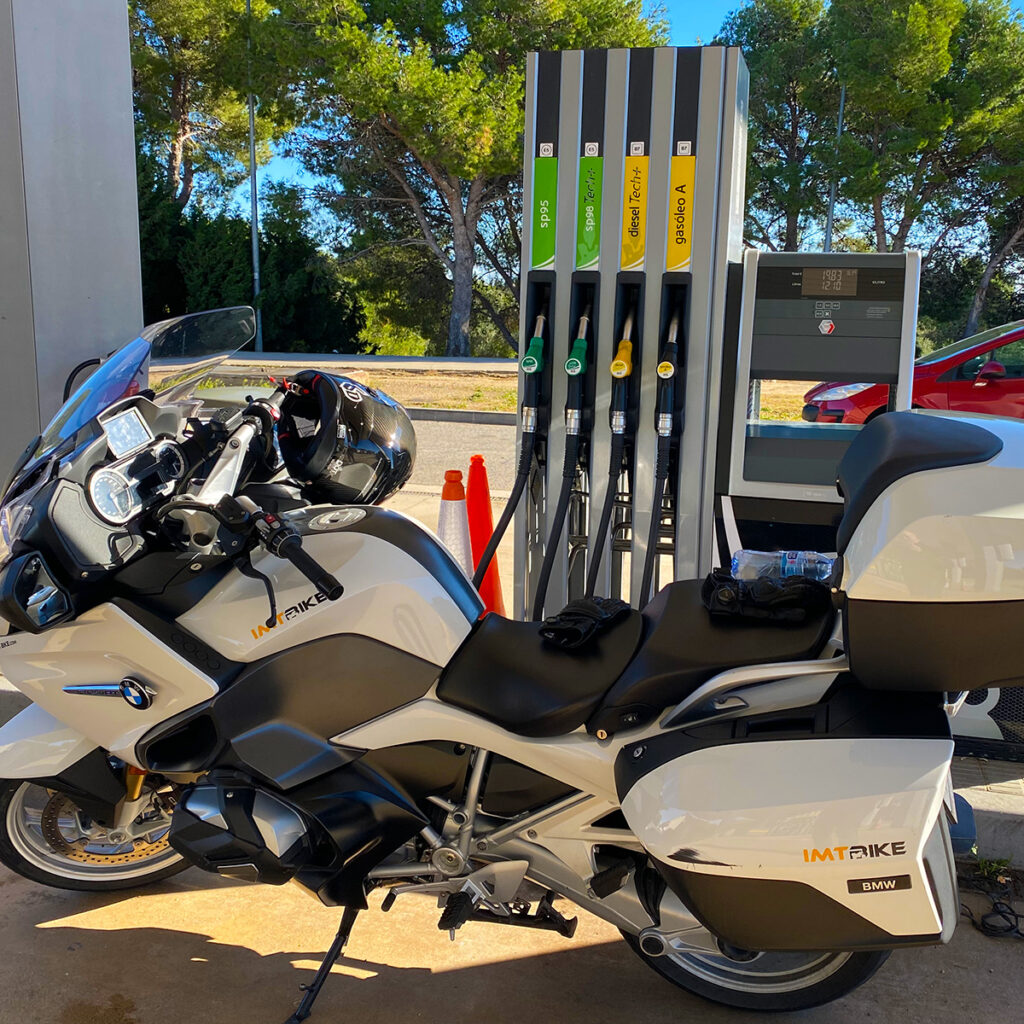
the inner life of cheesecake
I met Eddie at his hotel bar, where he was instructing the pretty bartender on how to make a gin martini.
“Stirred,” he said, “not shaken.”
“So you’re the anti-Bond,” I said. “You’re d-nob.”
“The D is silent,” he said. “Sometimes shaking it leaves ice chips. Nothing in life should be diluted.” He sipped it and nodded to the bartender. “Well done.”
“You did it,” she said.
He waved it off. “Not at all.”
“He only made extremely precise suggestions,” I said, sharing a smile with her.
The hotel concierge made reservations for us at Gastro Mercat Vaqueta, a lively place an eight-minute walk from the hotel, so we headed out fifteen minutes before nine, ungodly late for me to eat but I was adapting rapidly to Spain.
“I’m surprised we didn’t ride here,” Eddie said while we followed the hostess to our table. “I thought that was the whole point of what you do.”
“Sometimes, sometimes not. The whole point is riding to enhance the experience, to go beyond point A to point B. Normally, you go on vacations and everything is about what you’re going to do, where you’re going to go, what you’re going to see.”
We each scanned the QR code for Vaqueta’s menu.
“The ‘getting there’ part is a necessary evil,” I continued. “But riding a motorcycle connects you with things. You’re involved. More focus is necessary. You enrich the ‘getting there’ and everything else about the experience.” I grinned. “And it’s a hell of a lot of fun rolling up to somewhere nice on a bike.”
Eddie looked off, to somewhere distant and fantastic. “I need to start riding again.”
Dinner came in the form of a series of dishes—sushi, antipasti, a gorgonzola burger, a beautifully aged porterhouse—climaxing with a tremendous—tremendous—cheesecake. I know. Cheesecake isn’t a nouveau pastry—tiramisu supplanted it on menus like grunge supplanted hair metal for those with no taste in music—but this cheesecake, not light, not heavy, not a compromise, with a firm crust and a browned, bubbled skin offsetting a rich inner life that I’d never know, this cheesecake was a love letter from a romantic pastry chef, signed with a streak of berry coulis.
“I’m in love with this cheesecake,” I said.
Eddie didn’t look up. “We’ll be dueling to the death for it, then.”
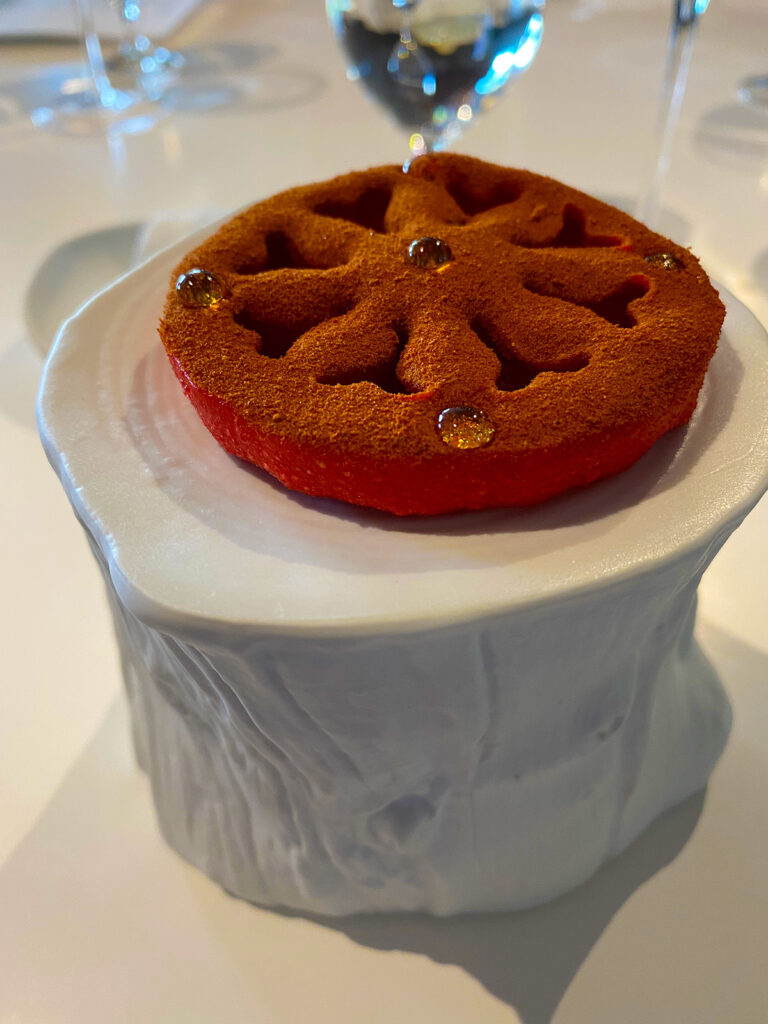
THERE IS NO COLD
A cold morning ride through the mountains of Alicante proved equal parts uncomfortable and glorious. Knifing the 1250RT through the curves distracted me from the cold, the heated grips and seat dulled the cold, the touring jacket’s superiority over the elements kept the wind outside, and the Outlast undershirt fought to keep me at a normal body temperature. As motorcyclists, we mediate the elements. You can’t wear too little in the heat, you can’t wear too much in the cold. Your ability to put the bike where you want it is paramount. Discomfort distracts from the motorcycling experience, so riding outside the 55-80 degrees (Fahrenheit) Goldilocks zone tends to be a balance of risk and mobility and comfort.
I was balancing mobility and comfort. The sweater would have been a welcome extra layer, but my movement would have descended to that of the Michelin Man—appropriate given my destination was Quique Dacosta in Denía, one of fewer than 140 Michelin three-star restaurants on the planet. Instead, I’d opted for ease of movement and an exercise in mental toughness. Chills threatened, I ignored them. When a shiver rose from my boots, I let it move through me before returning to my motorcycle zen (link).
Do not try and ignore the cold, that’s impossible. Instead, only try to realize the truth… there is no cold.
The sun rose, the cold eased, and I found myself in Denía for lunch at Quique Dacosta, joining Eddie and my soon-to-be-new-friends Flashman, a private pilot for a household-name tech magnate, and Flashman’s girlfriend, Elle—a poet—who graciously agreed to speak in prose throughout our experience (as the content team at QD HQ characterize lunch at their renowned establishment).
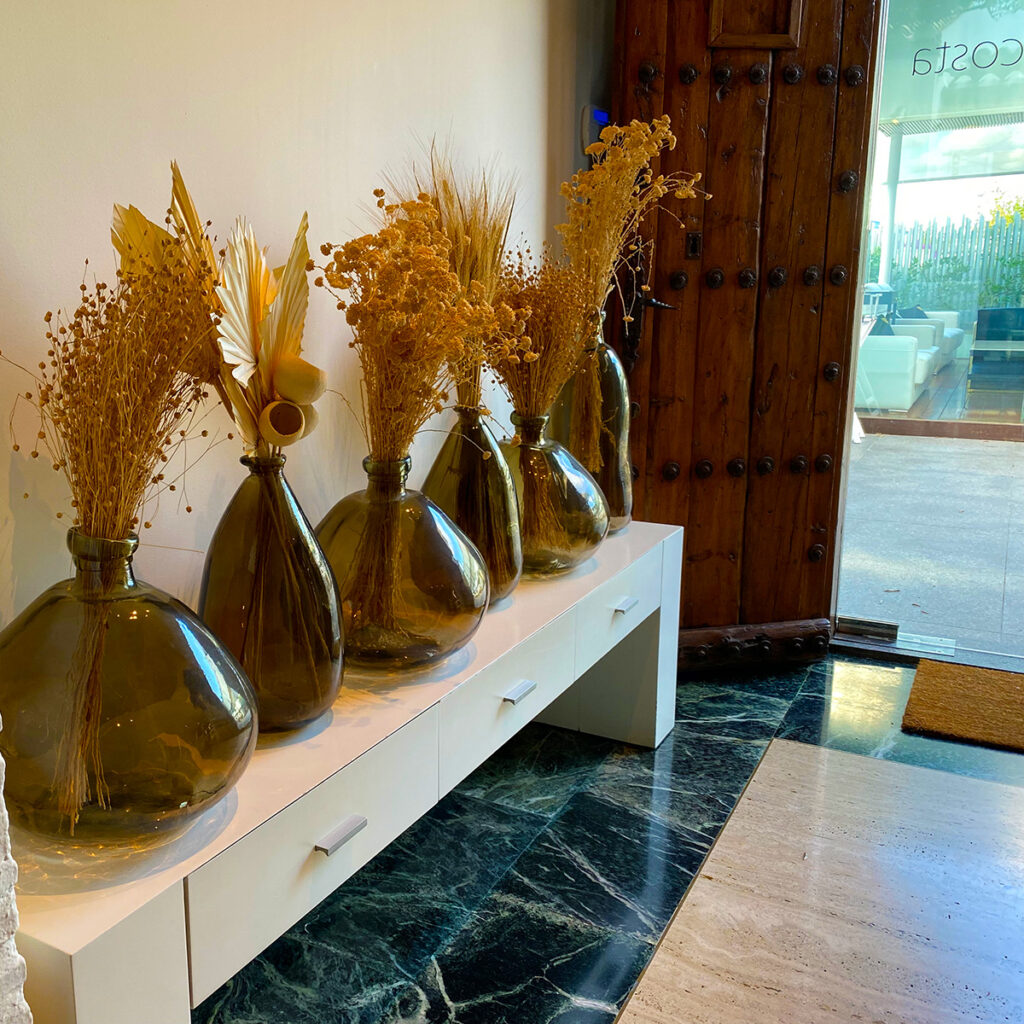
THE EDGE OF FLUENCY
The restaurant’s design—glass and wood and tasteful muted tones, large arched windows, white walls and tablecloths—prepares you for your meal as much as the wait staff and the pre-tasting menu bites. The restaurant is quiet, respectful of the food and surroundings, but not weird and reverent and, as much as I like to mock marketing copy, I sensed the parties at the other tables were, indeed, there for the experience. Eddie sat to my right, Flashman to my left, and Elle across the table, an elaborate coral reef centerpiece between us.
Eddie, Flashman, and Elle went for the wine pairings, but given I rarely drink—at weddings and restaurant experiences, and then only champagne, port, and the odd excellent dessert wine—I said, “Agua, por favor, con la excepción de la champagna y vino desserte. Y port. Me gusto port, tambien.”
Our waiters—there were three—winced throughout my butchery of their language, and the closest responded, in perfect English, “Still or sparkling, sir?”
“Que?” I asked, and laughed, the loudest person in the room, leaving Elle unimpressed, before tucking my tail and mumbling, “Still, please. Gracias.”
From thousands of miles away, Euclid asked, “You’re not going to publish that, are you?”
I ignored him, smiled at everyone, and said, “Four years of Spanish in high school.”
“I can’t speak a word of it,” Flashman said. “It sounded fine to me.”
Elle shrugged. “They understood you.”
Eddie raised a glass. “To friends.”

WE OPEN WITH DONUTS
We toasted and chatted before the serving team arrived with the first course of a lunch experience that would last more than four hours—a hollow donut of pumpkin and black truffle, decorated with orange flower petals. The sommelier presented the wine pairing, describing the wine’s origin, history, and why he’d paired it with the donut. Eddie took a photo of the bottle. A rhythm was established. Consommés followed, foams ensued, a memorable trio of aged tunas stands out, a mock tomato slice we came to call “the pizza” substituted for dishes that violated this or that food allergy or dishes one of us might not be willing to sample.
The sommelier paired a course with a bottle from a South American high-altitude vineyard.
Flashman swirled the wine in his glass, sniffed, blanched.
“What’s wrong?” Elle asked.
“You know how certain smells will transport you to memories?”
“Yes.”
“This smells like the Victorian toilet at Rothesay.”
“On the Isle of Bute?” she said. “Where they wanted us to pay twenty pounds to look at an old toilet?”
Flashman laughed with unbridled joy. “This wine smells just like it!”
“Is the Isle of Bute known for its wines?” I asked Eddie, who shook his head.
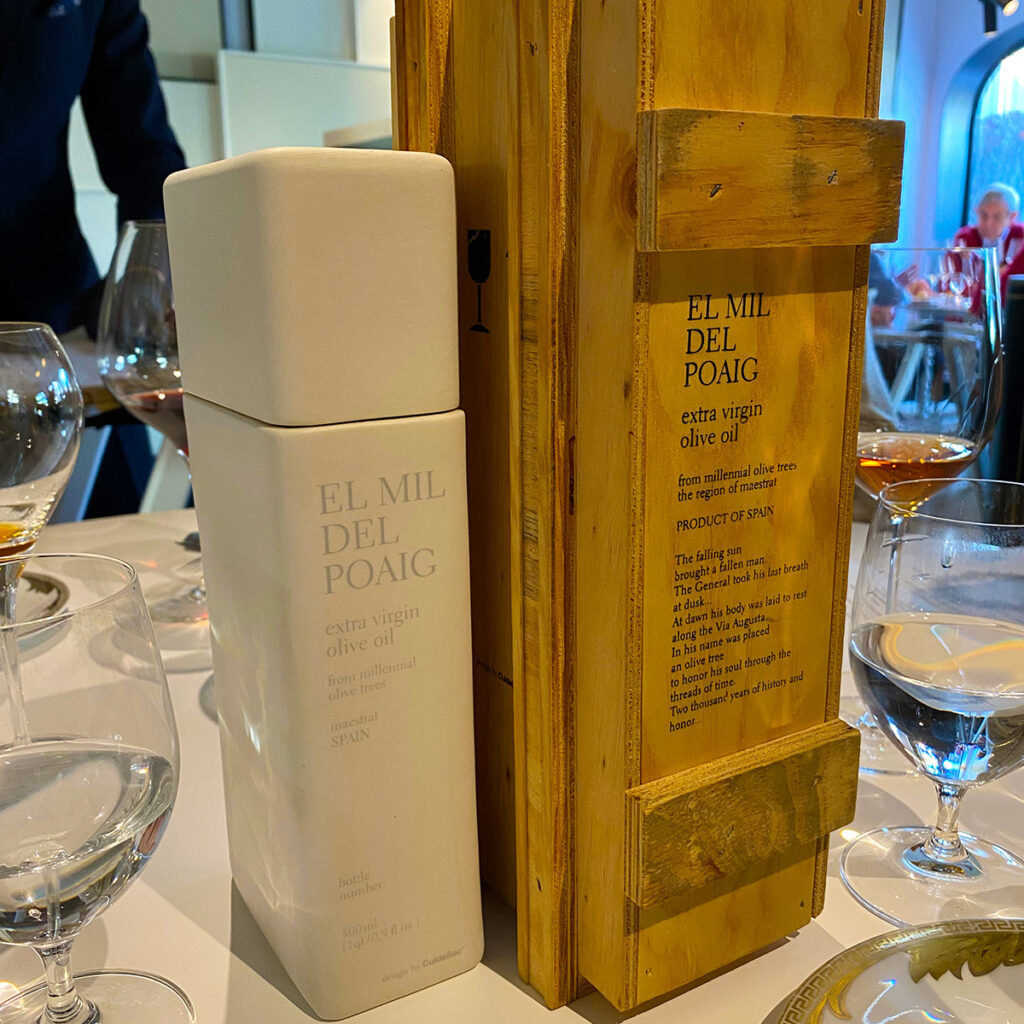
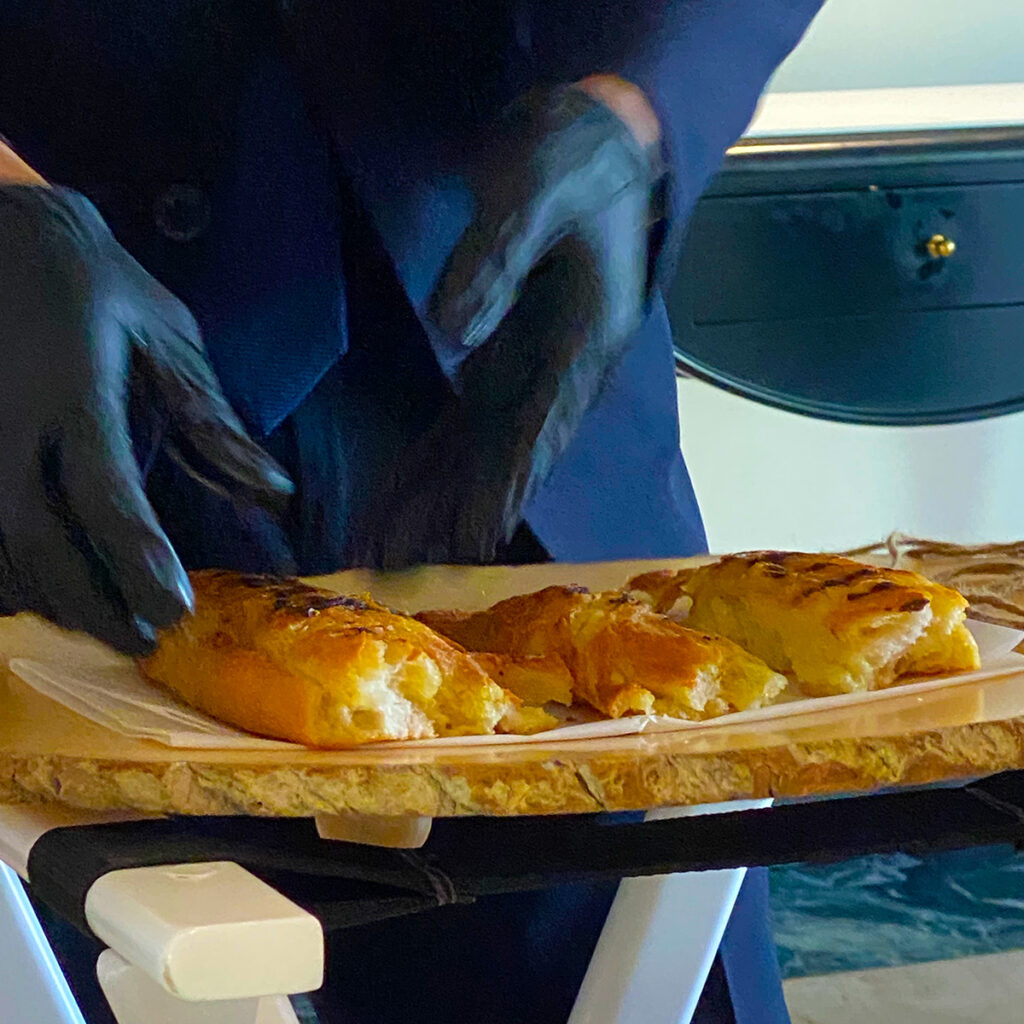
YOUR YOUTH ROARING AT YOU
An autumn pumpkin celebration with pumpkin rice, roasted butter foam, pumpkin seeds, and diced pumpkin conjured ancient memories of the harvest. Grilled focaccia drizzled with superlative olive oil preceded a hare and garlic soup I couldn’t stomach.
Elle’s presence tempered the men’s stories, keeping us classy and equal to our surroundings. Flashman and Eddie raved about the food and wines in San Sebastian.
The desserts came: a selection of cheeses, honey in multiple forms—including the comb, which I love—a dark and wonderful dessert wine, faux whole green almonds made from almonds, carob and sheep’s milk caramelized and formed into seed pods, a simple cookie with pumpkin seeds and powdered sugar, a single-bite impersonation of raspberry that exploded in your mouth, along with espresso, which I didn’t need to sweeten.
My companions were properly sauced after the many wine pairings, and pleased with a bottle Eddie had selected toward the end of our experience. Elle sat quietly while Eddie considered a side gig as a sommelier.
“Can’t do this like I used to.” Flashman took a small sip of wine. “My younger self is disappointed in me.”
“When I became a man,” Elle said with the glow of eternal youth, “I put away childish things.”
Eddie poured himself another glass. “Tomorrow it’ll feel like I’m being biblically punished.”
Flashman leaned forward. “Like your youth’s roaring at you.”
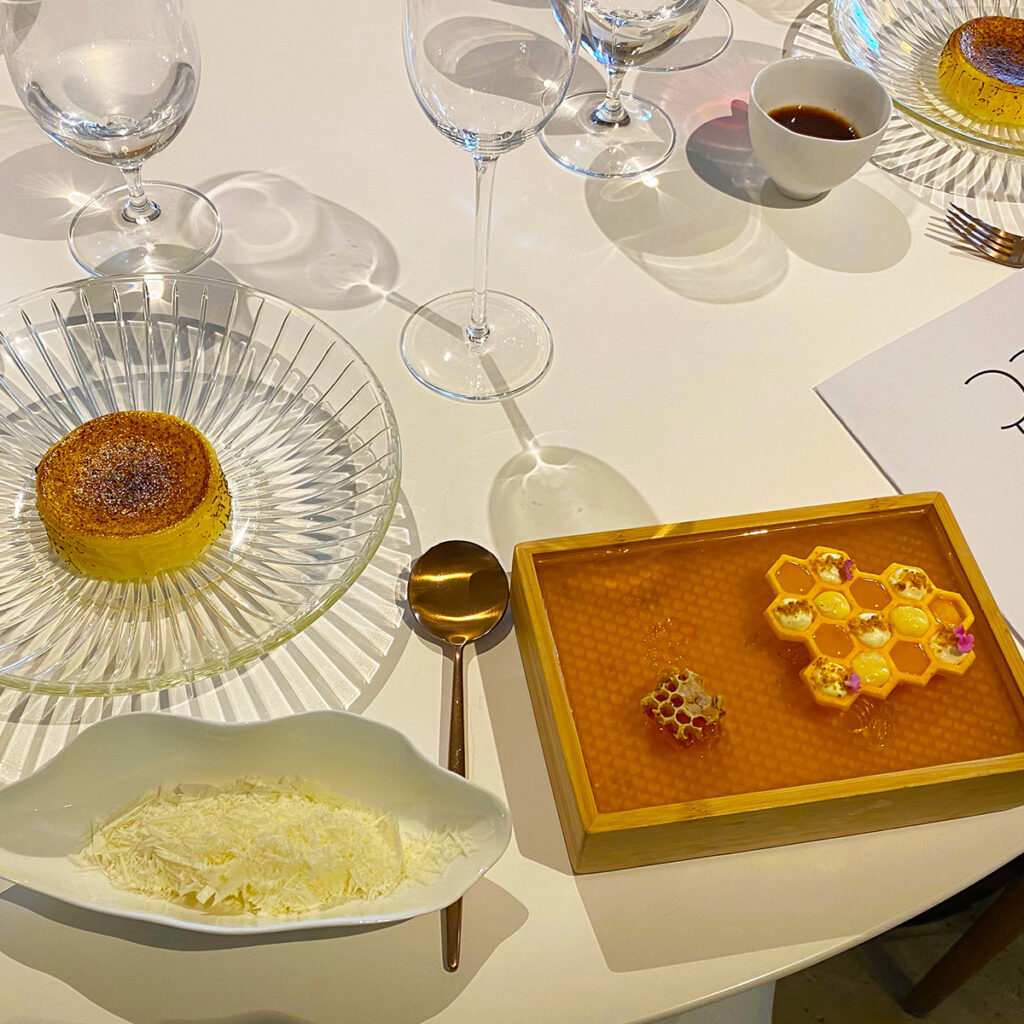
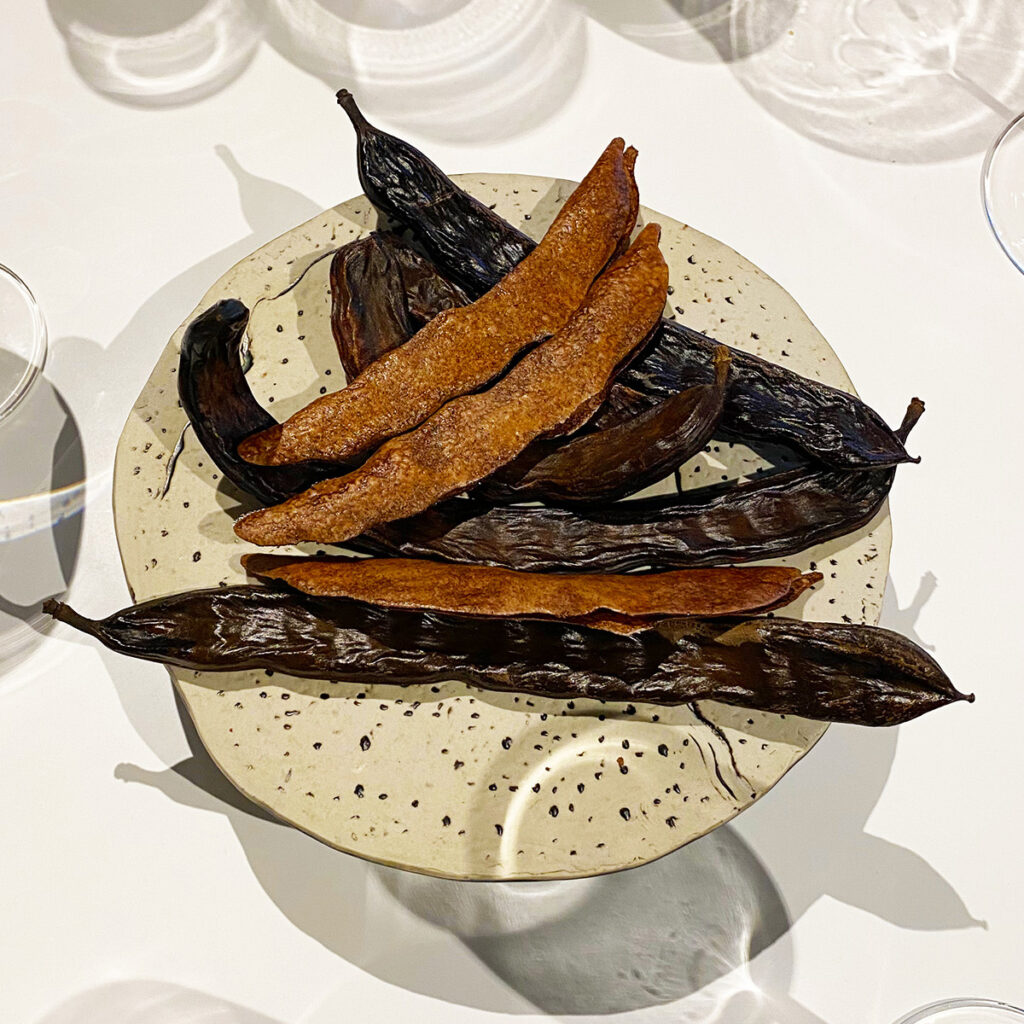
More than four hours after our experience had commenced, we walked through the glass doors into the cold Denía evening. One of Quique Dacosta’s staff took our photo next to the cartoonish cow.
“We should meet next summer in San Sebastian,” Eddie said. “Best food in Spain.”
“Riding through the Pyrenees is supposed to be amazing,” I said.
“Schedule allowing, we’re in,” Flashman said, at which Elle nodded.
We said our goodbyes and vowed on the old gods and the new that we’d meet in San Sebastian in nine months’ time.
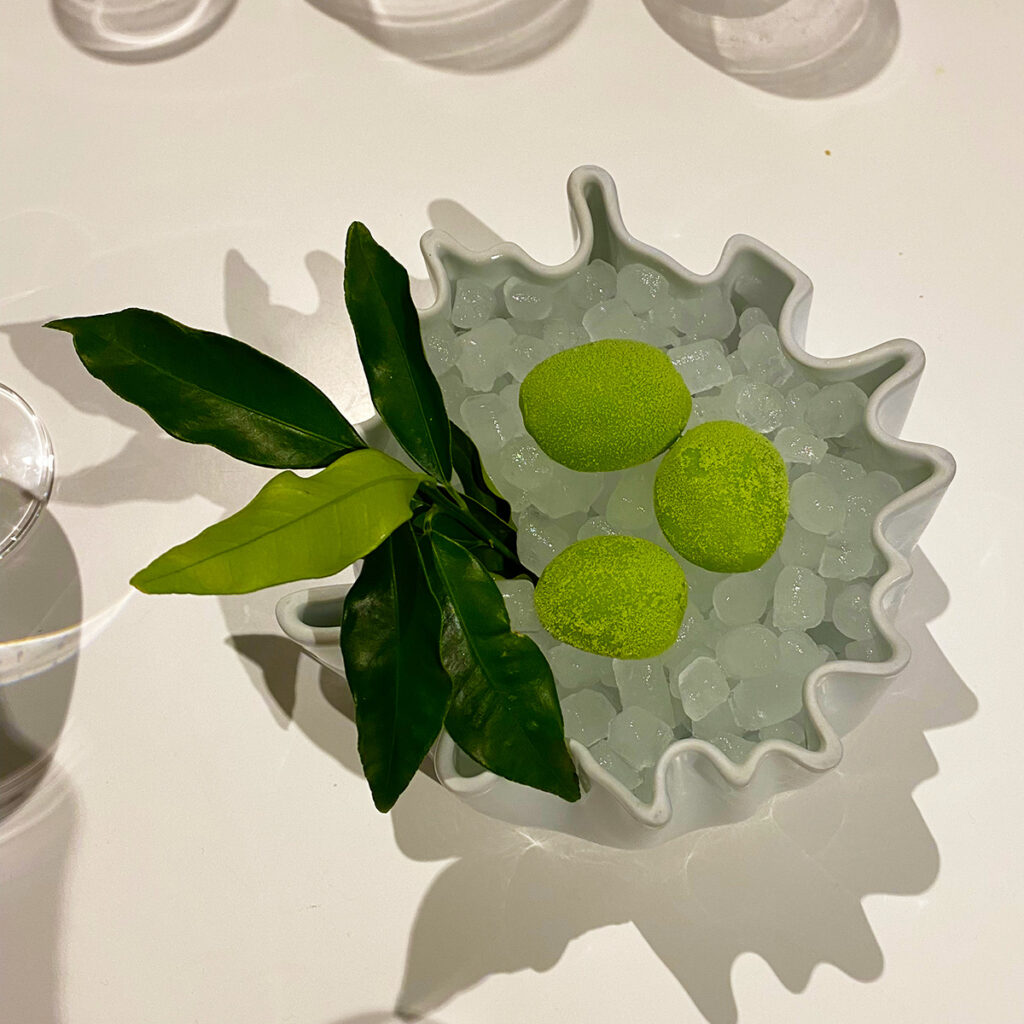
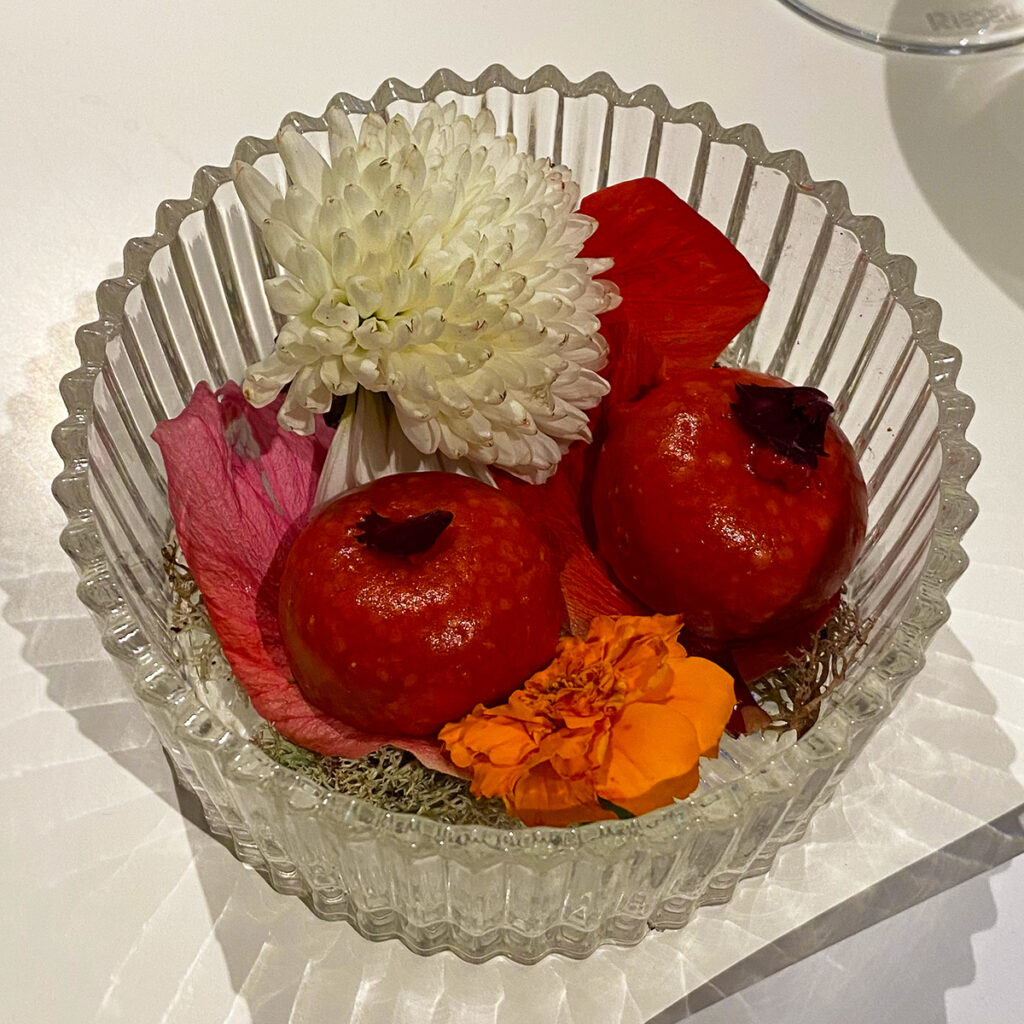
THE SOUND OF IRRESISTIBILITY
I woke moments before sunrise. The glass wall of my room at Vivood Landscape Hotel overlooked a valley and a small village. The early sunlight burned copper on the peaks surrounding the valley and held for several minutes, before rushing down the mountain walls to the village. After sunrise, I did a quick workout in the room, showered, and met Eddie in the resort’s restaurant for breakfast.
We talked business, ex-wives, and whether the woman sitting at the next table was single while we waited for breakfast. Soon the waiter placed a breakfasty charcuterie tray before us, with jamón, cheeses, a small crusty loaf of bread, orange juice, strawberries. I ordered a breakfast burrito—it was fantastic—and all was well in the world.
“Valencia?” Eddie asked.
“Down the mountain and back to the city for our last night.”
“I’m thinking the cheesecake place again.”
“I concur,” I said. “Vaqueta.” I pulled up a restaurant reservation app and made reservations for nine o’clock, an ungodly late time for me to eat dinner, but the barest beginning of the evening meal for Spaniards.
When I’d finished, Eddie said, “We should find dates for tonight.”
“Any idea how we’re going to accomplish that between when we arrive in Valencia and our reservations?”
“Meet me at my hotel at five and we’ll just sit in the bar and strike up conversations with women.”
“With our limited language skills?”
“Love is its own language,” Eddie said.
“The ‘bar to restaurant’ move didn’t work for me even when I was young and good-looking.”
Eddie considered this. “Maybe we can try a ‘can you help us out here? We don’t speak Spanish’ angle.”
“So the pity angle.”
“As a last resort,” he said. “Hopefully, our broken Spanish will prove irresistible.”
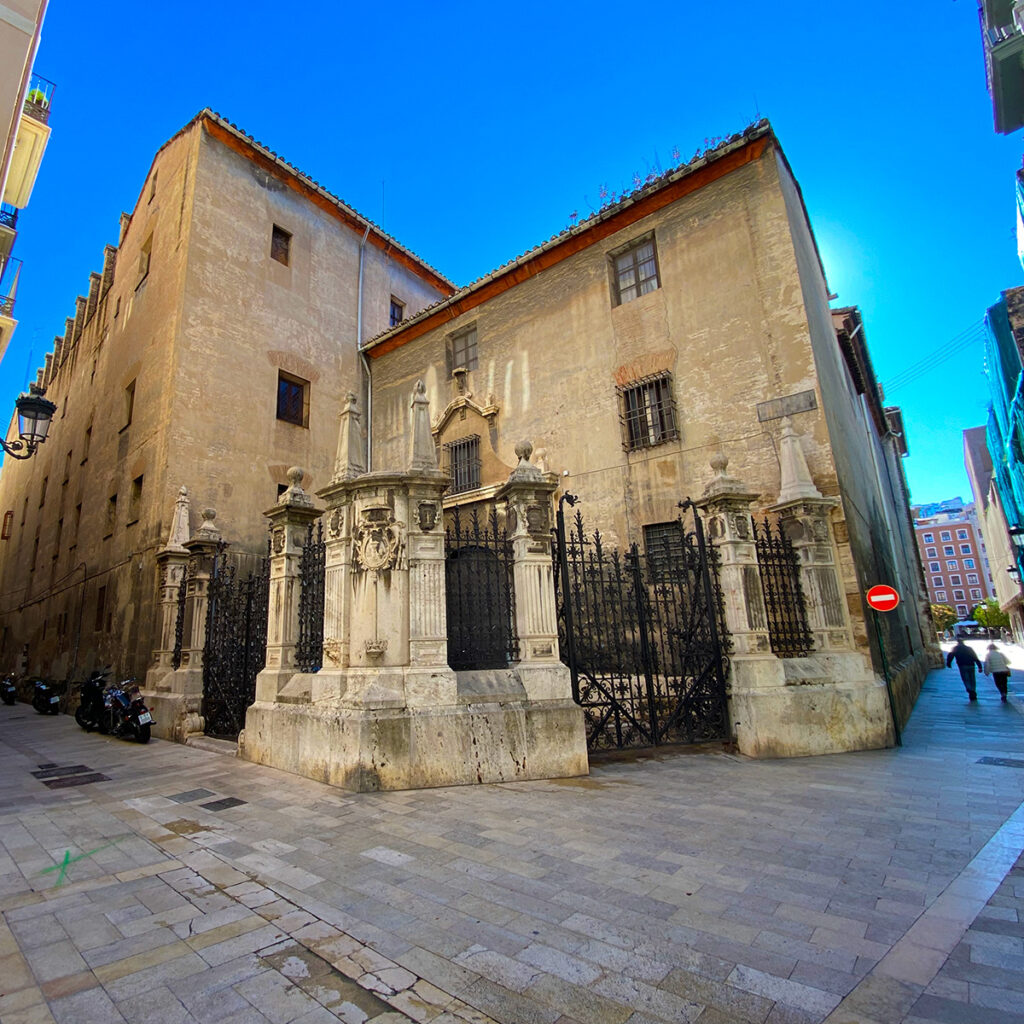
STYLE AND BADASSERY
The mountain route back proved the better route. Lots of other bikes, tight curves, sweeping high-speed bends, incredible views, a few too-heavy braking moments, and nearly a million “I wish I had my Streetfighter for this” yearns.
I rode tight around rock faces, the big BMW handling well but not perfectly on the dry pavement. The panniers and rear luggage compartment did little to help my balance, and I found myself comparing it to my bikes at home. The BMW excelled mechanically. It always started. It did what I asked of it. But it was more point A to point B than I preferred. It got me where I wanted to go but lacked style and badassery.
What differentiates what I love to do—luxury motorcycle travel—from normal travel is, of course, the motorcycle. Destination travel, the structure of most travel—“we went here, then there, we saw this and that, it’s a long drive to there, it’s a twelve-hour flight,” etc.—is entirely different when the travel between destinations is on a motorcycle. I’m immersed, in flow, the “getting there” a pleasure, not a necessary evil.
And I don’t want to criticize the BMW. It was excellent. Perfect. No less, no more.
I arrived in Valencia earlier than expected, which enabled Eddie and me to walk around the city, expounding on our 2022 business plans, talking hotels and wine and motorcycles and cars, but ultimately failing in our half-hearted quest to find dates for Vaqueta. As the sun set on Valencia and the street and store lamps rose, we headed to our respective hotels, without dates but with visions of cheesecake dancing in our minds.
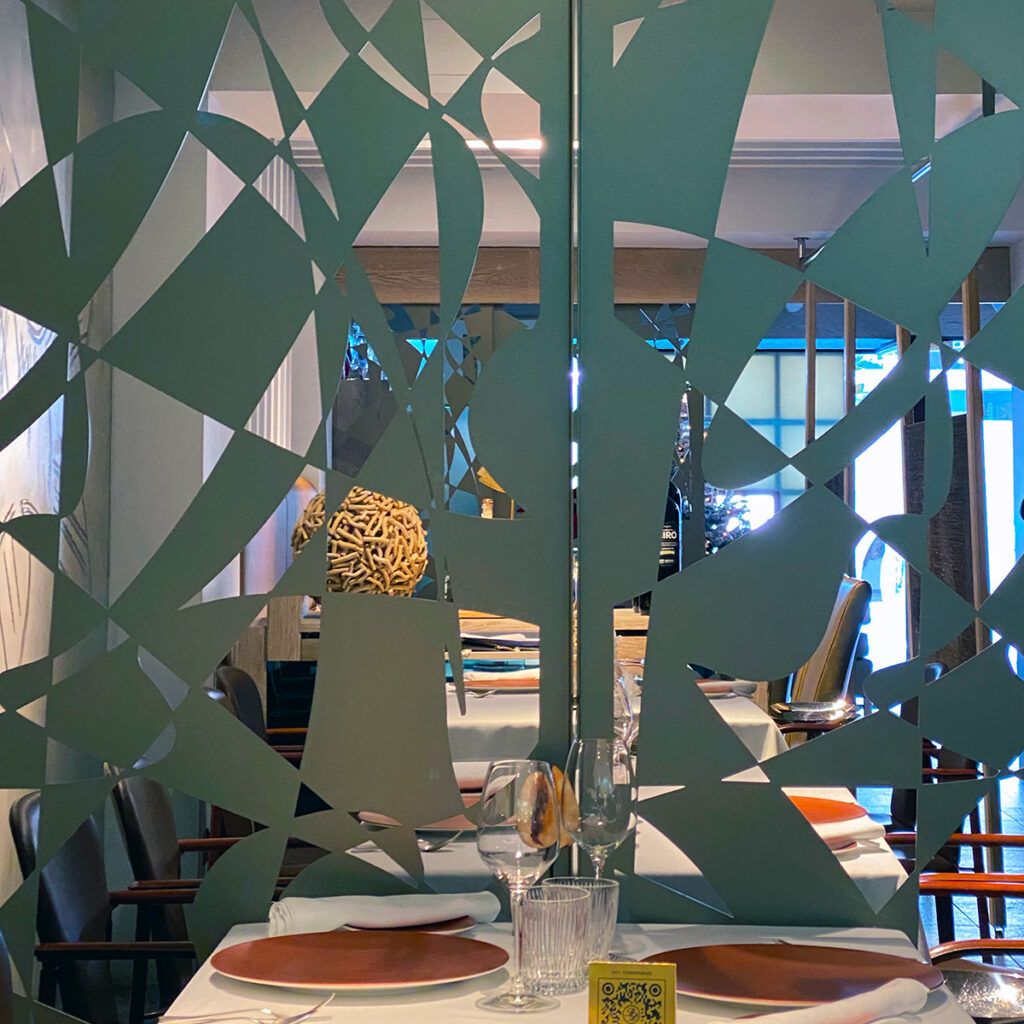
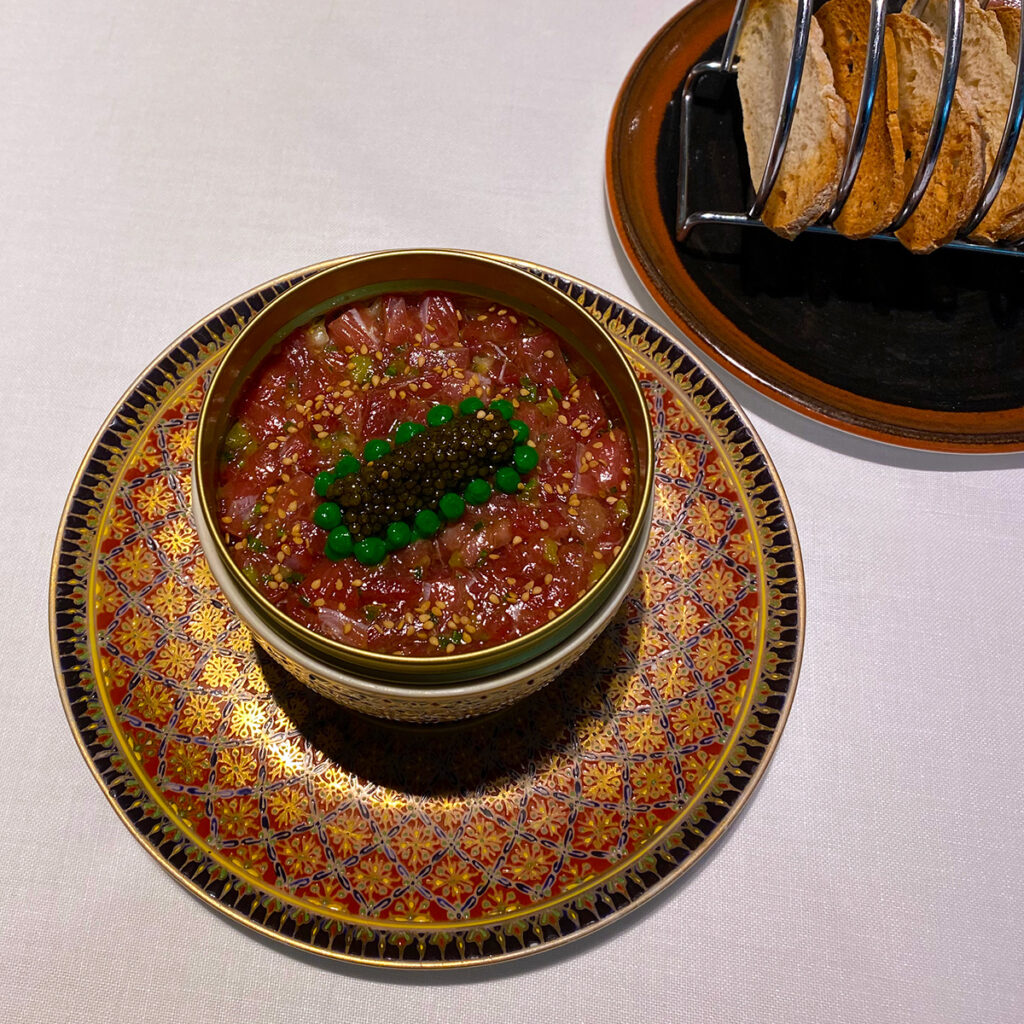
AN EXQUISITE OREO AMONGST THE HONEY
Eddie caught his plane to London in the morning, and I rode the coast to Tarragona, to see Roman ruins—the Amfiteatre de Tarragona and the Ferreres Aqueduct, both recommended by Flashman during our long lunch at Quique Dacosta—and eat at Rincón de Diego, before riding the last miles to Barcelona.
Much like sports fans who watch a twenty-minute segment of Olympic figure skating or women’s gymnastics and can capably serve as judges—
“He missed that triple Lutz, which is an automatic point-two deduction.”
“Her floor routine lacked creativity and flow. She needed an eight-point-seven, but all I’m seeing is an eight-point-four max. Gold to the U.S.”
—after eating at a variety of Michelin-star restaurants, you just sort of know when a certain place is satisfied with their star, or you know when a two-star is hungry for three. You also know when the staff is unimpressed but curious why you rode up on a motorcycle and changed clothes right there in the street, transforming from Dashing Motorcycle Adventurer to Pretentious Dude Who Fancies Himself a Food Critic, in front of the plate glass, multi-building-material façade, and post-modern rusted door.
That said, having performed said change in the middle of the street, and now in my Spanish fine dining uniform of Superdry sea green sweater and super sleek black suede hip-length John Varvatos jacket, I felt pretty fucking cool, and was doing exactly what I love doing. #pretentiousdudewhofancieshimselfafoodcritic
Rincón de Diego’s dining room is gorgeous. The Iberian Cured Ham from Acorn-fed Pigs and Country Bread with Tomato and Olive Oil was excellent, as was the holy-crap-I-could-eat-this-every-goddamn-day-and-I-don’t-even-like-caviar Tartar with Red Tuna, Avocado and Beluga Caviar. The sirloin steak with mushrooms and truffle sauce was good, as was the Live México, a fun orchestra of chocolate, lime, coconut, and vanilla ice cream, which, from above, looked like an exquisite Oreo. The espresso was a 7 of 10, without need for sugar or honey.
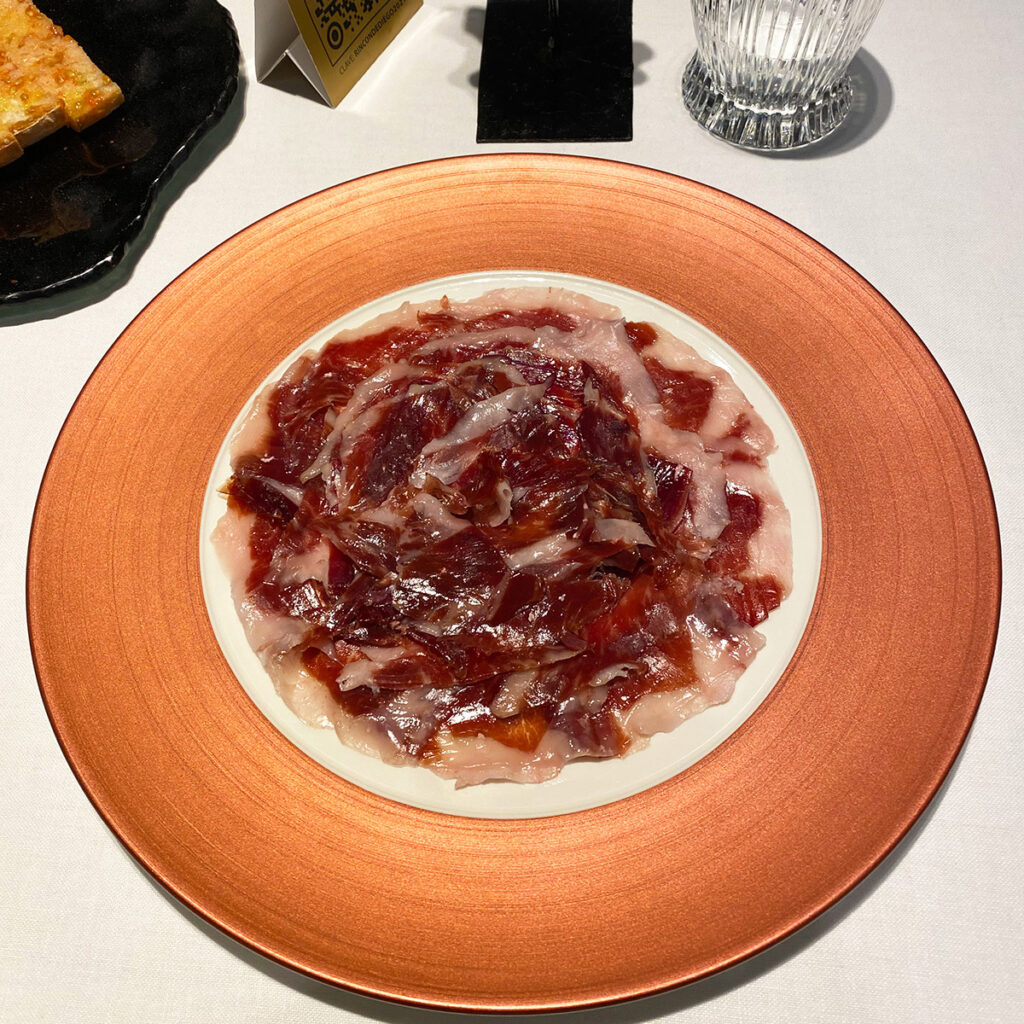
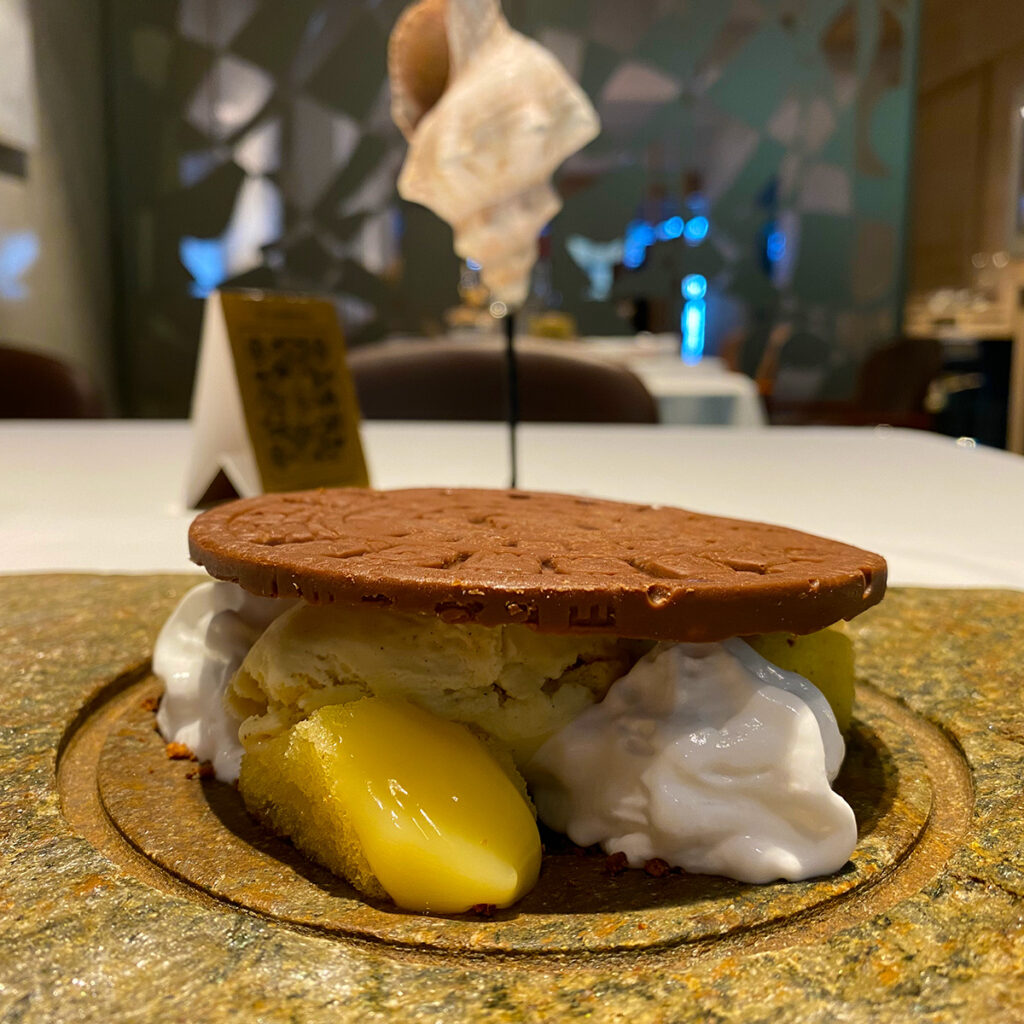
DASHING MOTORCYCLE ADVENTURER
After lunch I changed in the street—once again the Dashing Motorcycle Adventurer—visited the Roman Ruins, sent off a few “Hey, look where I am!” texts with photos to friends in the States, and rode north, the twilight chasing me and finally catching me on Barcelona’s outskirts. I turned in the BMW and took a taxi to Las Ramblas, where the driver stopped and demanded I get out and walk the remainder of the way to my hotel, because getting me to the hotel’s front door was an impossibility. He was correct.
It was a beautiful, cold night, and people of all ages packed the Las Ramblas area. Pre-covid, had I appreciated places like this so much, the people and shops and food, and optimistic, charged atmospheres? I’d like to think so, but certainly not with a “this could be lost” perspective.
I checked into the Kimpton Vividora, an elegant, modern hotel with excellent design, a capable staff, and bordering-on-sensual showers. I took a shower, put on my uniform of sweater and jacket, and hit the streets, stopping in shops, people watching, and cruising La Boqueria, where I picked up perfectly ripe strawberries, jamón, and soft Basque cheese. Dinner secured, I relaxed in the ninth-floor lobby bar for a while and had the strawberries, jamón, and cheese in my room, before crashing hard and sleeping a dark, dreamless sleep.
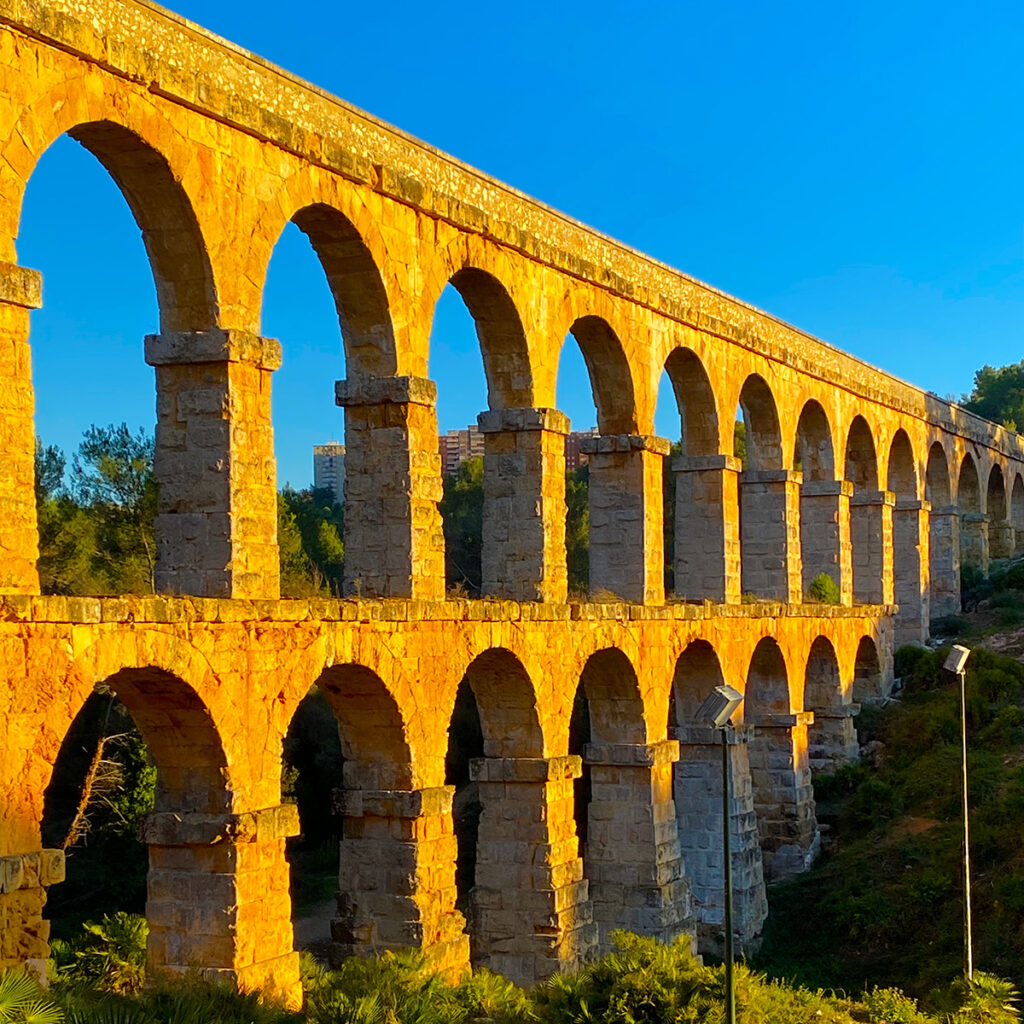
COCINA HERMANOS TORRES
I visited the Gaudi Park in the morning, and half-walked, half-taxied to a coffee shop off the beaten path. I won’t betray its awesome localness by naming it. Over the next hour or so I enjoyed a leisurely espresso, muffin, and fresh-squeezed juice, before walking fewer than ten minutes to what would be the star meal of my Tour de España—Cocina Hermanos Torres.
With a distinctive, barn-like white front, painted with tall, lean, sparsely leaved trees of varying shades of gray and brown, leading to a modern, minimalist dining room with a central, open kitchen, Cocina Hermanos Torres (CDT) did not waste time on pretense. I arrived early and enjoyed the restaurant’s gradual filling. Bright white tablecloths set the tone, giant stainless stove hoods loomed above the cooking and plating stations, and Christmas-in-California white holiday lights hovered below a warehouse A-frame ceiling striped with skylights. Everything was delicious, they accommodated my at-times limited tastes, my primary server was a delight.
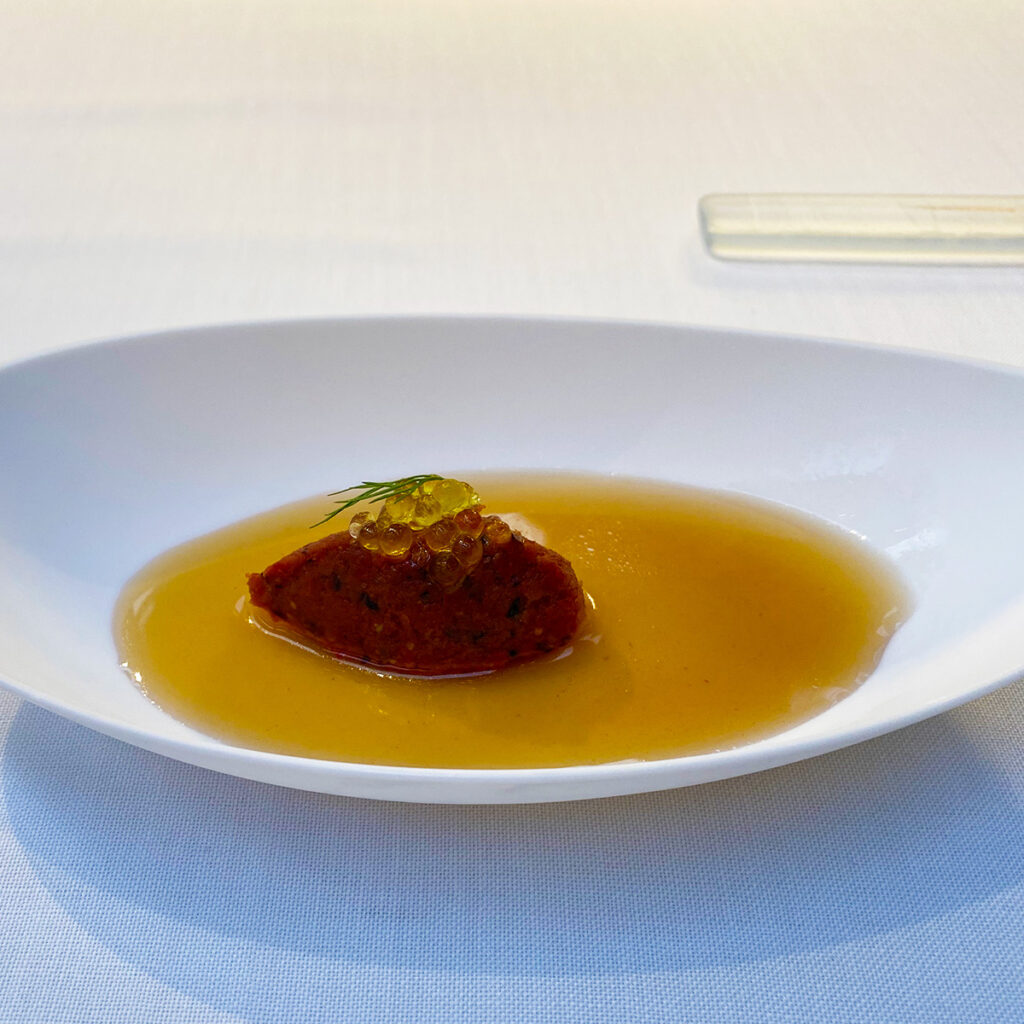

AND I DON'T EVEN LIKE SOUP
Early in the lunch, CDT substituted a dish I wouldn’t eat with a tomato tartare with olive oil “caviar.” Golden olive oil spheres atop a gorgeous, deep red tartare of tomato—explosive taste with a fulfilling “wholeness” courtesy of the olive oil caviar. One of the entire tour’s stars.
Another star was yet another substitute dish, a red thistle broth—the thistle from northern Spain, with onion and truffle flakes.
Unexpected hits kept on coming. Onion soup—I don’t really like onions or soup—made from onions caramelized for 18 hours, with cured parmesan cheese and melanosporum truffles. The tastes of the caramelized onion and the Parmesan built on each other, the Parmesan heavier but not overwhelming.
A “soup” made from the “first flowering of Maresme peas” paired with Iberian bacon. The peas popped, crunchy on the outside, the bacon rounding the dish into something more than its constituents, as bacon often will. Had my mom made peas like this when I was a child, I might have eaten them.

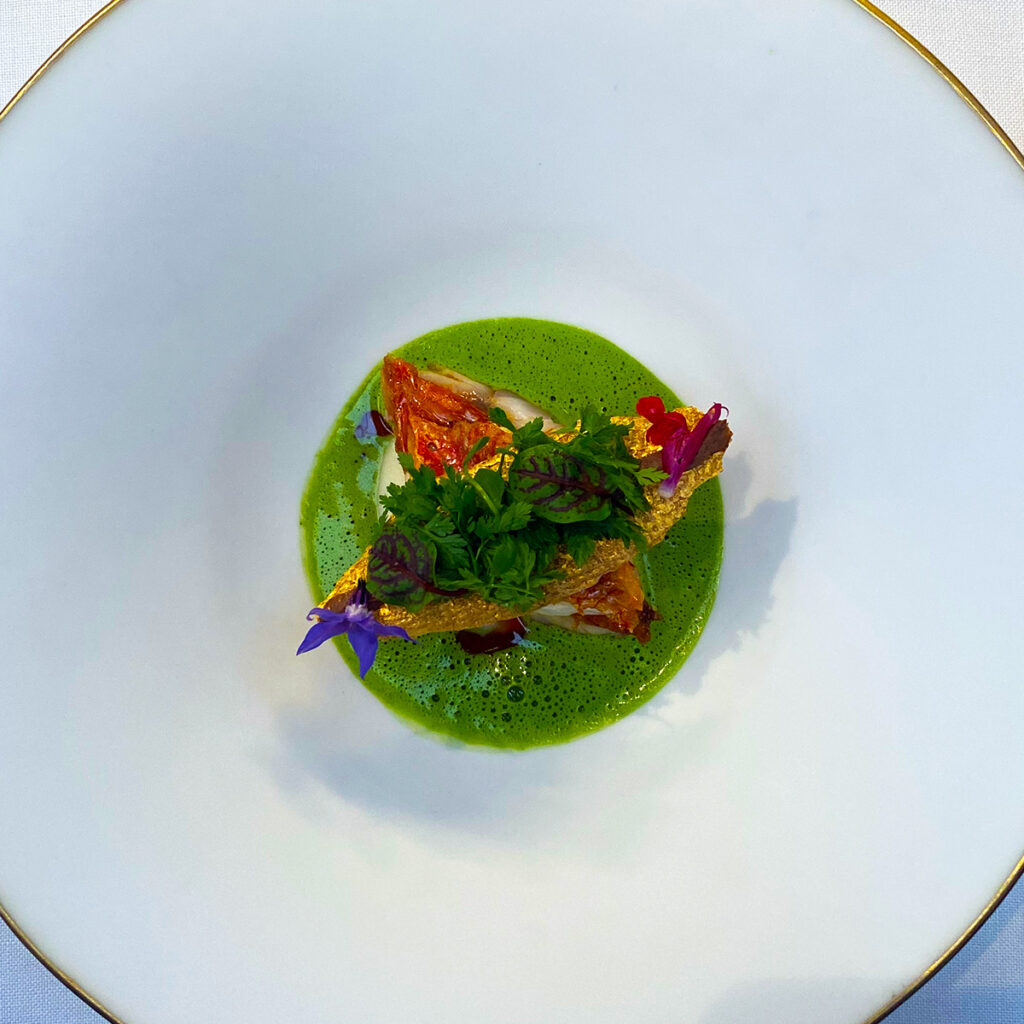
'MERICA
A main course of Iberian suckling pig, pears, tamarind, flowers, and “Migas de Pastor”—shepherds’ crumbs—was sweet and savory, the skin of the suckling pig ridiculously good and flooded with umami, though the crescent of shepherds’ crumbs detracted from what I wanted it to be, so maybe I’m not good with complexity. ‘Merica!
A cheese flan with truffled ice cream opened the dessert courses, delivering a caramel dulce de leche taste, but with the cheese’s restraint. The ice cream was lost taste-wise, but maybe it was perfect—because I wanted more caramel, and it wouldn’t give it to me—a sweet tease.
Following the flan was pomegranate sorbet with hibiscus foam, pomegranate seeds, and pickled beet root—which whisked me back to my childhood and the first “fancy” restaurant my dad took me to—Tony’s in St. Louis—where dinner began with a sorbet palate cleanser and I was like, “Mom! Dad! Ice cream to start?!”
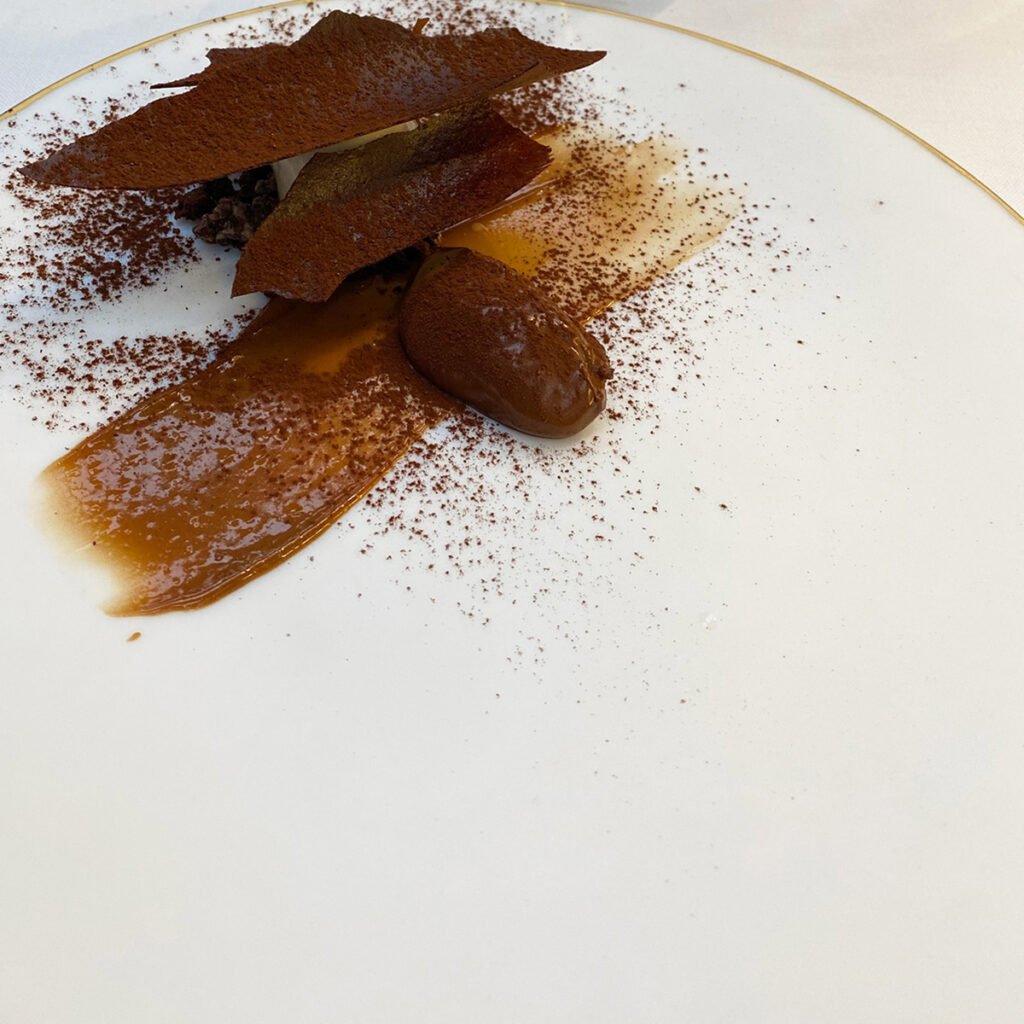
AGE OF COCOA
Which all served as prelude to the Age of Cocoa, a dessert towering above most others. The tiny pudding separated the fine chocolate from the lessers with its complexity and depth. The ice cream came from the pulp of the chocolate bean, delivering a sour taste that set off the richer, sweeter chocolates. Even the achingly thin wafers were dense with complexity, offering three, four waves of chocolate. Really impressive, an all-time favorite, an entry on the Worldwide Dessert Power Rankings.
A few small bites followed, including The Jewel, served in a jewel case of sorts, which began with a crunchy, marble-looking shell, concealing a filling of chocolate, fruit, and rum.
The espresso needed sugar, as some do. That said, their espresso presentation was world class, and an espresso without need for sweetening might have disappointed me in this one circumstance.
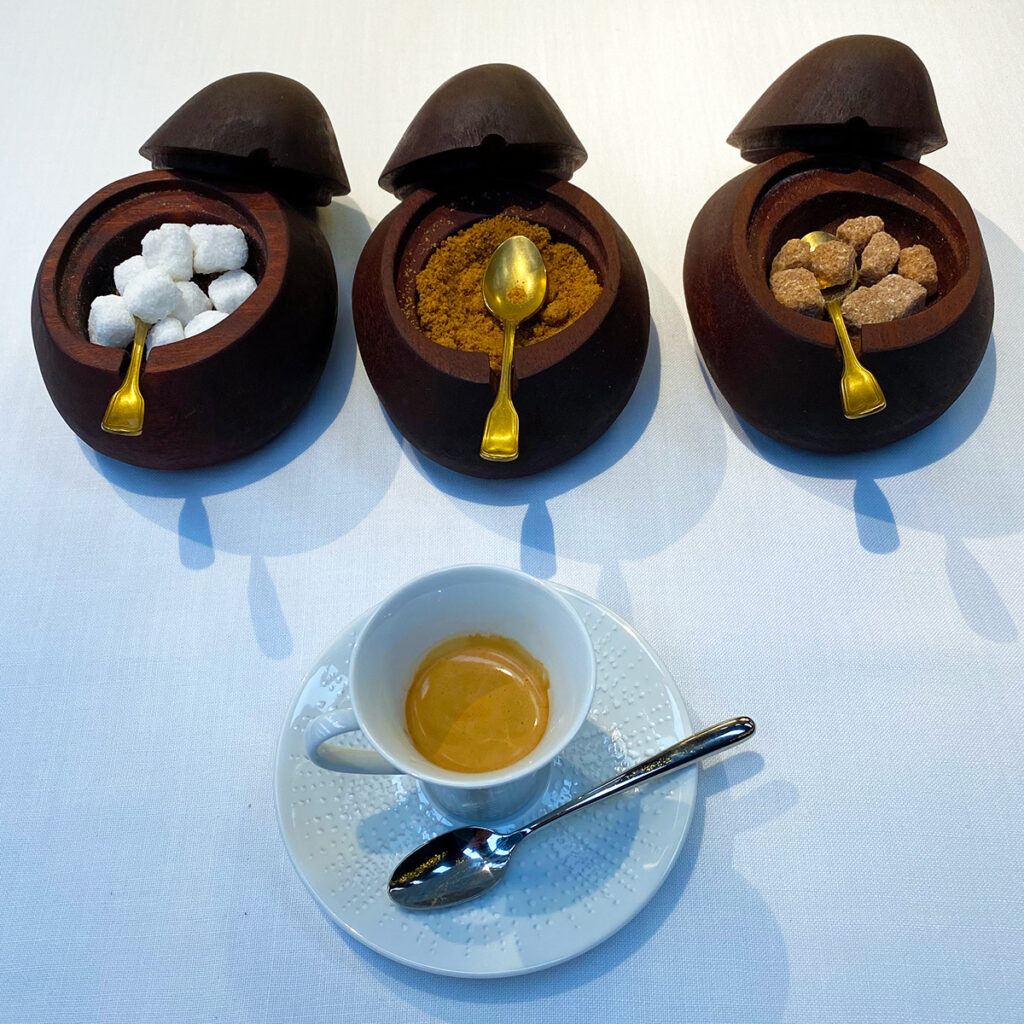
BEST MEAL EVER?
My lunch’s finale consisted of a chocolate truffle with a wonderful crispy shell that continued to be crispy as I chewed, long after mere mortal shells would have ceased, and L’Or coffee caviar, a “cloud” of chocolate, coffee caviar, and gold. Excellent and subtle, visually it was the coffee caviar’s show, but taste-wise, texturally, the cloud, a highly aerated nougat-like chunk, stole the scene.
Around me tables emptied and filled, and something like sadness crept in. Was this the best meal I’d ever had? Did it measure up to memories of long-ago Chasen’s in Hollywood, or the original Spago, or the original Lutece, before they changed locations and jumped the shark with a line of frozen food? What about that crazy-good mom-n-pop in Rome—Gusto Sando—their cacio e pepe reason enough to fly to the Eternal City, or that nameless place in New Orleans’ French Quarter with the triple chocolate bread pudding?
Unanswerable questions. It was impossible to compare distant memories with this moment. What meal can compare to food memories idealized by time and hardened by nostalgia? It was like comparing modern baseball players to those a century ago. You could, but you couldn’t. That I’d attempted to do so said a lot for Cocina Hermanos Torres.
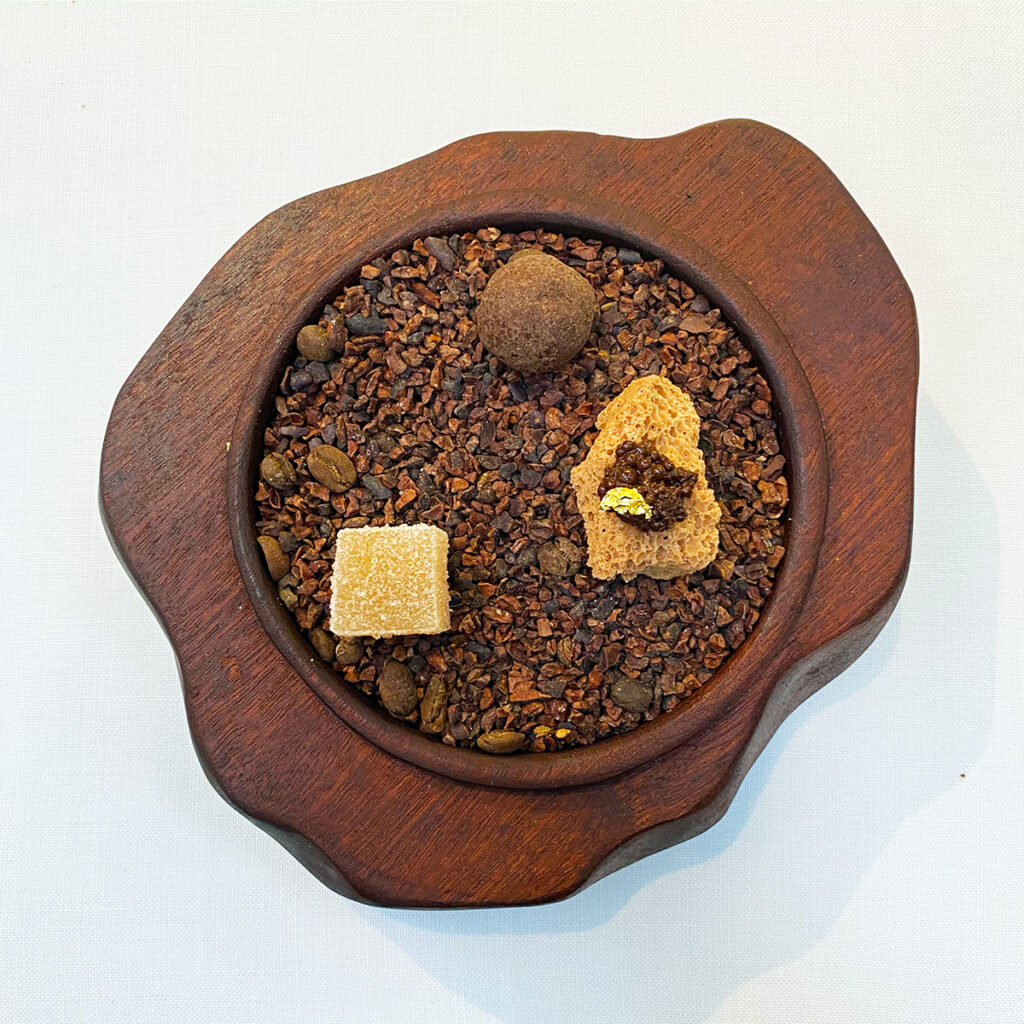
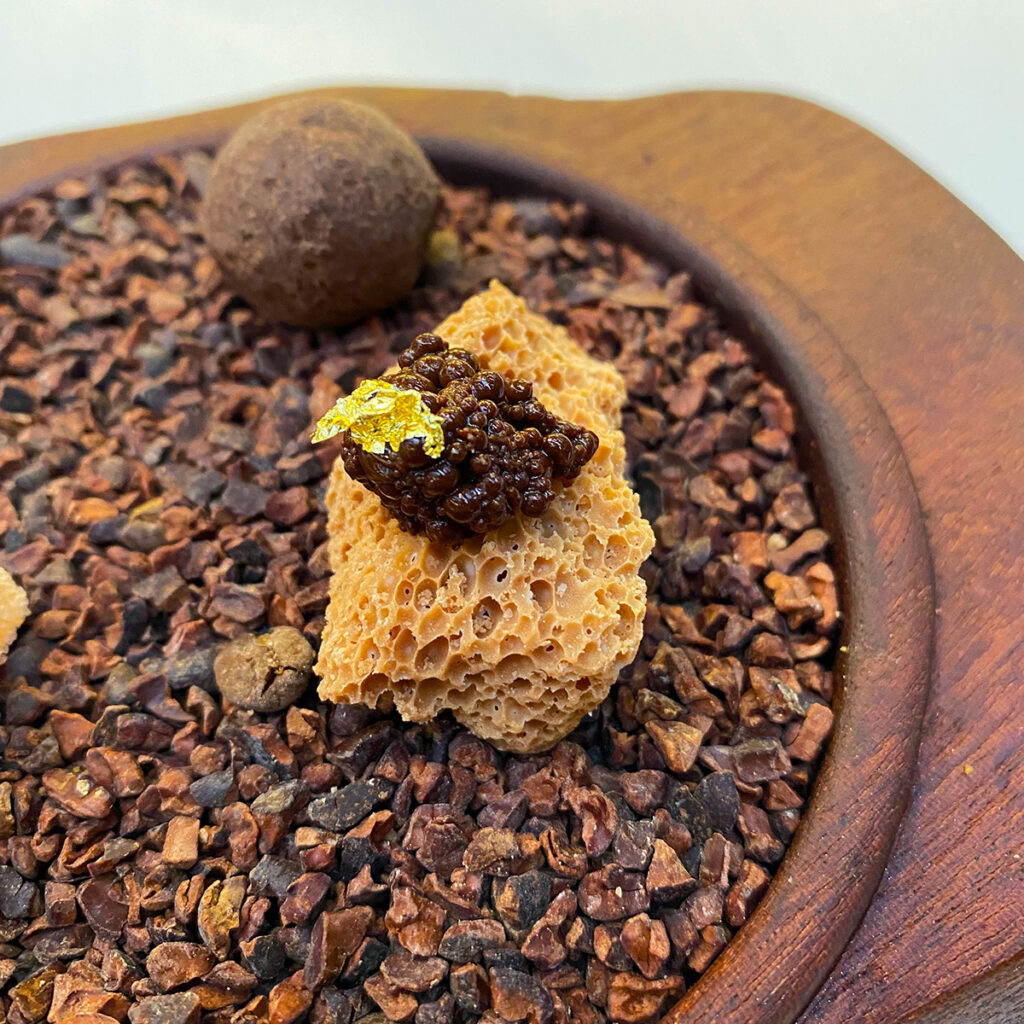
DOS PALILLOS, TRES NUEVOS AMIGOS
I passed the door to Dos Palillos twice, before ducking into what looked like a sushi bar to ask for directions, only to discover this was the restaurant’s first-come, first-served section, with the horseshoe “I’ve got reservations” bar in the back.
Four solo diners—including me—had made reservations for the night, at about the same time, which was odd and awesome simultaneously. Dos Palillos sat us together at the corner of the bar, perhaps to see what would happen. I sat on the corner.
The bar was dark wood, with black lamps and red napkins. The kitchen stood in the center of the horseshoe bar, and a man tended what looked like Korean barbeque.
Dos Palillos is an Asian/Spanish fusion kitchen, which pairs your dishes with sake—if you so choose—and leaves you with chopsticks if you don’t ask for a fork, which most diners are likely embarrassed to do, including myself. Chopsticks are like riding a bike, so I would only look like an idiot for five or ten minutes.
“I’m Paolo, and I’ll be your guide tonight,” said the thirty-something man behind the bar. “Do any of you have any allergies?” he began, explaining to us how the night would progress, asking who wanted their courses paired variously with wine and sake—not for me, thanks—and who was willing to pay extra for the addition of a berry mochi and wagyu beef sushi to their tasting menu’s itinerary. Uh, hell yeah.
The details down, Paulo left us to wonder how, of all the sake joints in the world, the four of us had happened into this place tonight.
I introduced myself and said, “I’m from California,” because, historically, telling new acquaintances I’m from the United States is never enough.
“Which part?”
“Southern, between L.A. and San Diego.”
A few nods until the woman farthest from me on my left said, “I’m Hanne, from Oslo.”
The woman next to me raised her hand slightly. “Analee. I live in Copenhagen.”
“I’m Liam,” said the man on my right. “Vienna.”
We talked food, wine, places we’d been, and restaurants we’d experienced. This was a well-traveled group who ate at fantastic restaurants—fancy foodies!—and it was clear I had some catching up to do.
After a small amount of sea urchin over wasabi crackers, Paolo presented each of us with a small white lidded bowl.
“Sea urchin flan,” he announced, and left us to it.
Beneath the lid was a smooth, dark orange surface, below which mysteries hid.
I pierced the smooth surface with a small spoon and scooped out what seemed to be sea urchin consommé, with a neutral flan to provide texture.
“This is really good,” I said. My dinner companions nodded and made noises that wouldn’t interrupt their enjoyment.
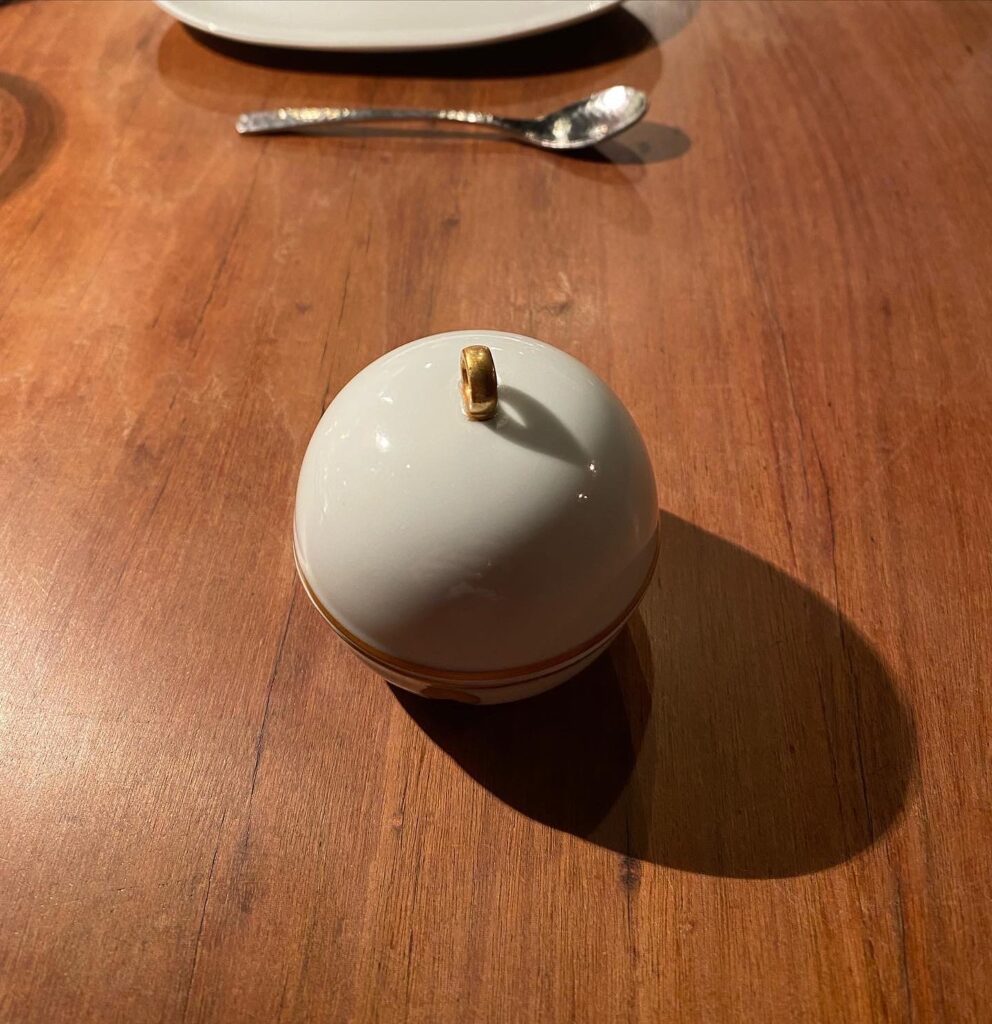
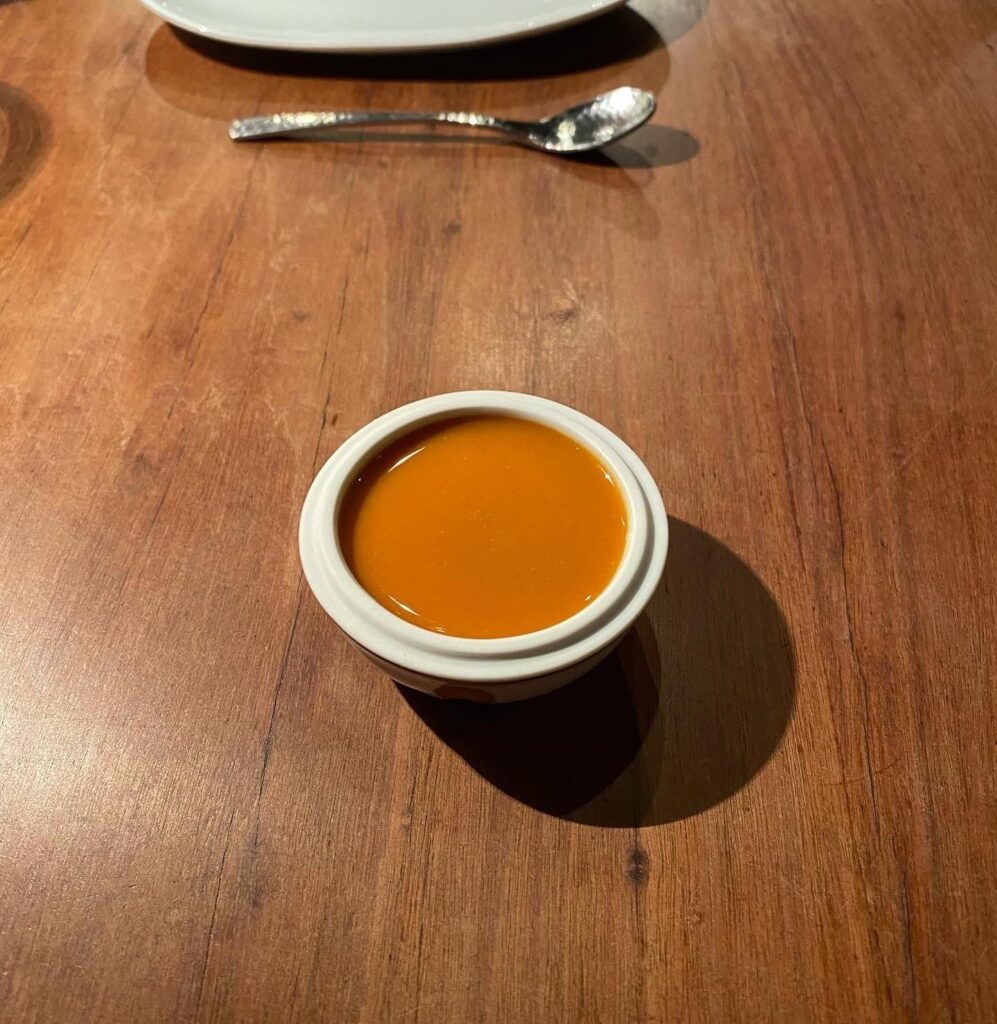
Between courses, we asked Hanne what she did for a living.
“I’m a university professor in Oslo. I teach technological safety.”
“Like passwords?”
“More than that. The philosophy behind it, how to keep yourself safe, the balance and tradeoffs of privacy and convenience.”
Paolo set a wood platform before each of us, with four items.
“Tuna belly sashimi. This is sushi rice, drizzled with the world’s most expensive balsamic vinaigrette—”
We ooo’d and ahh’d.
“—a flower with petals of mullet, and I’ll ask you when you’re finished what you think the fourth dish is.”
Challenge accepted!
But I forgot everything when I tasted the tuna belly sashimi. It was, with no close second, the best sashimi I’ve had in my life. It melted in my mouth, the taste strong but reserved, fresh, luxurious, the sea’s resounding “Oh yeah? Try this,” response to the best Iberian jamón.
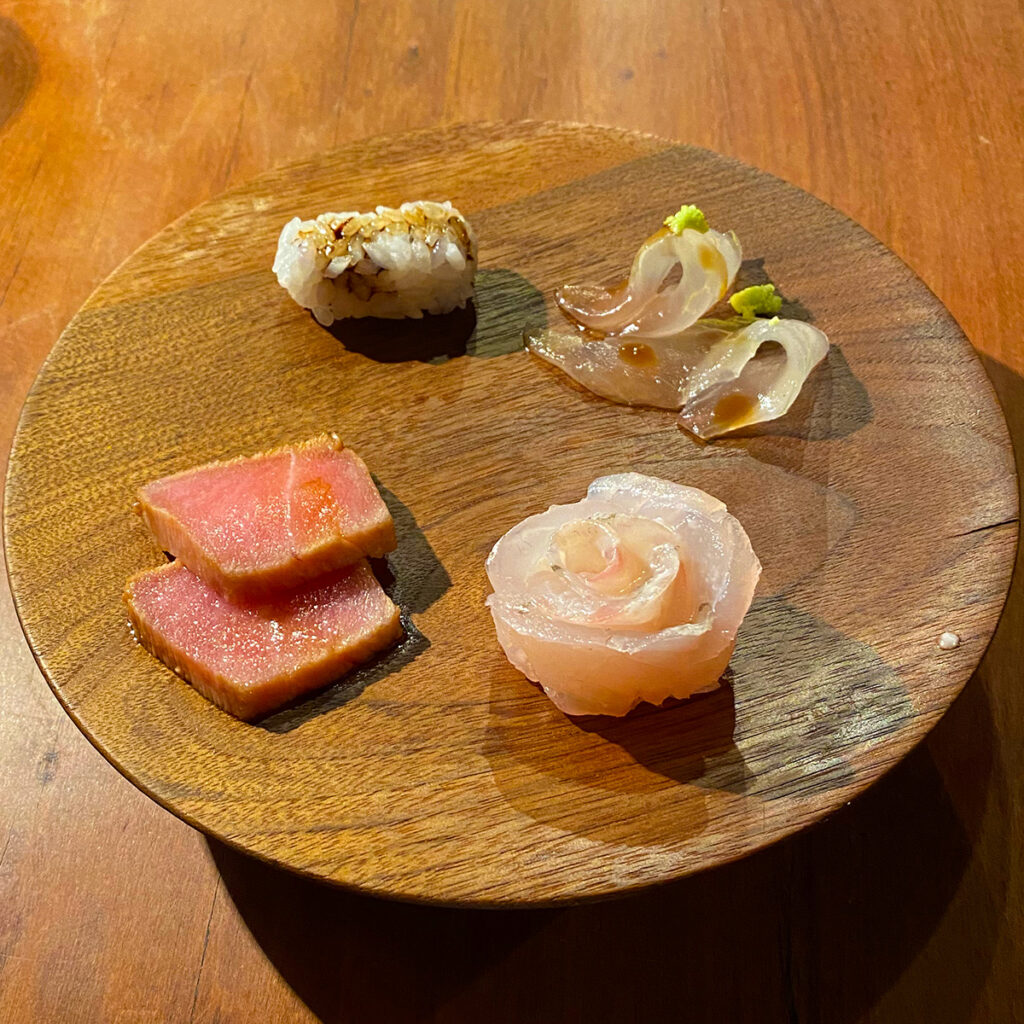
“Are you going to finish that?” I asked everyone at the bar who hadn’t yet finished their tuna belly sashimi. “I’m willing to pay you for it. American dollars.”
With no takers, and my solo dining mates busy on their phones pretending to ignore me after quickly wolfing down their tuna belly sashimi, I sat quietly with alternating waves of joy that this spectacular dish existed, and disappointment that two squares of the sashimi masterpiece were all I would experience for the foreseeable future.
I distracted myself from my sorrows with the rice and Acetaia Bellei—the most expensive balsamic vinaigrette in the world—but then wondered, given enough of the tuna belly to sate my desire, how the tuna belly and the sushi rice with vinaigrette might combine as sushi partners?
“I’m a UX designer,” Analee said when asked. “When you go onto an app, I design the layout, colors, fonts, everything involved in how you interact with the app. I shape your experience.”
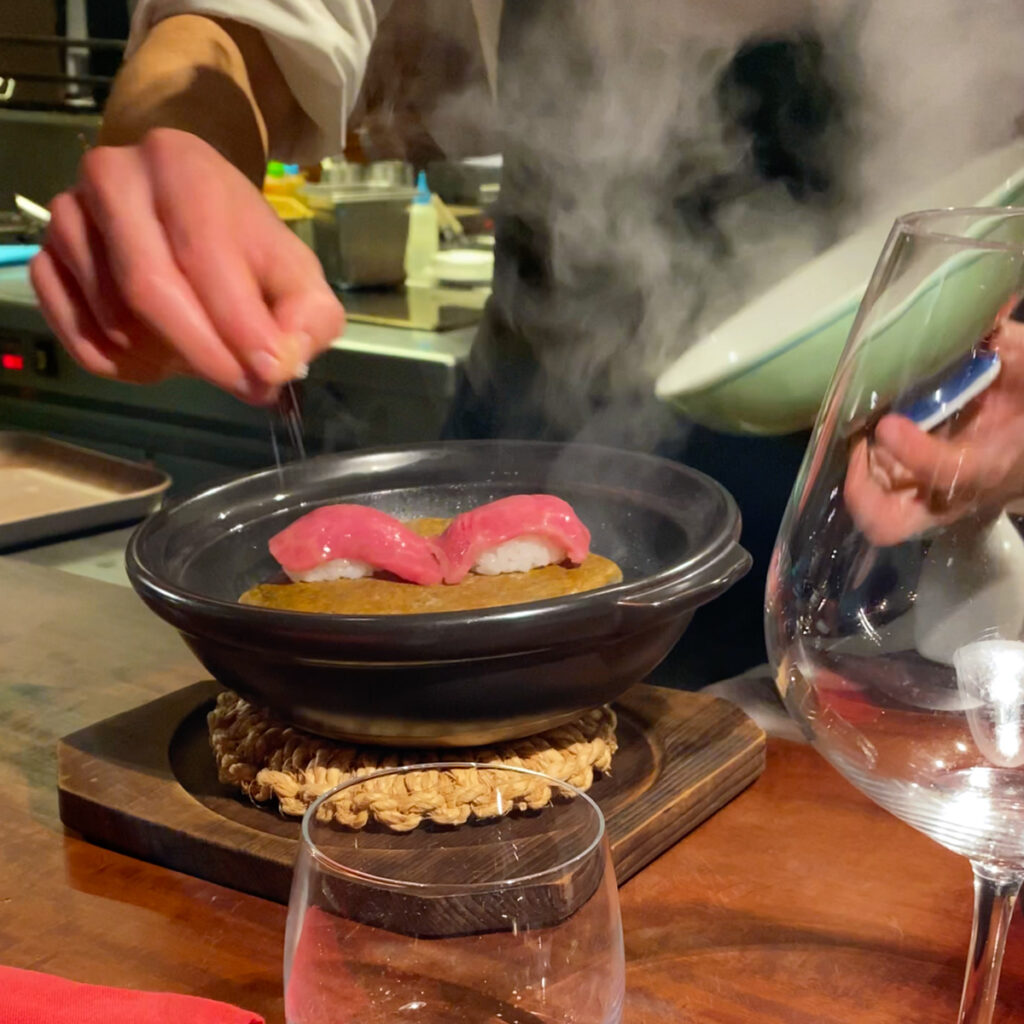
Dos Palillos offered many high points, but despite the restaurant’s uniform excellence, for me the tuna belly was the tasting menu’s superlative. Following it were unusual and fun fusion dishes such as dried oyster—which struck me as oyster jerky—a wonderful, slightly steamed wagyu beef sushi with coarse sea salt, and a deconstructed Korean barbeque sandwich, which was fun to construct.
Liam ran his family’s manufacturing concerns in Austria, after a hiatus working in a Michelin two-star restaurant.
“I was disenchanted, and so I quit,” he said.
“Your family’s business? That couldn’t have been easy.”
“No. But I wanted to work in a two- or three-star restaurant.”
We asked him what it’s like.

“The pressure is constant,” Liam said. “I would arrive at noon to begin the prep. Everything must be ready for the first covers of the evening. It is very hard. You work and work, never stop, and then the night is over. You go home late, sometimes one or two in the morning. You do it again the next day. It is always the same, the pressure.” He sipped his sake. “I loved it.”
“You loved it?”
He nodded.
“Then why did you leave and go back to your family business?”
“They needed me. They asked.” He shrugged. “Family.”
Across the bar someone gasped and wept at their first taste of the tuna belly sashimi.
“But they instituted another lockdown in Vienna two days ago, so I said, ‘I’m working remotely,’ and I flew here.” Liam laughed, and we laughed with him, all of us painfully understanding the desire to avoid lockdowns, and maybe a little jealous Liam could simply do it.
The desserts came and went—a pumpkin consommé creation topped by ice cream and dusted with cinnamon, a berry mochi, a curious ice cream sandwich which presented as an overfilled vanilla macaroon, and the requisite espresso—with the pumpkin dish taking the prize.
We talked as the Dos Palillos team cleaned the open kitchen. I begged Paolo for another tuna belly sashimi and was rewarded for my groveling.
“Now you’re begging for food?” Euclid asked in the back of my mind.
“It’s worth the self-inflicted humiliation.”
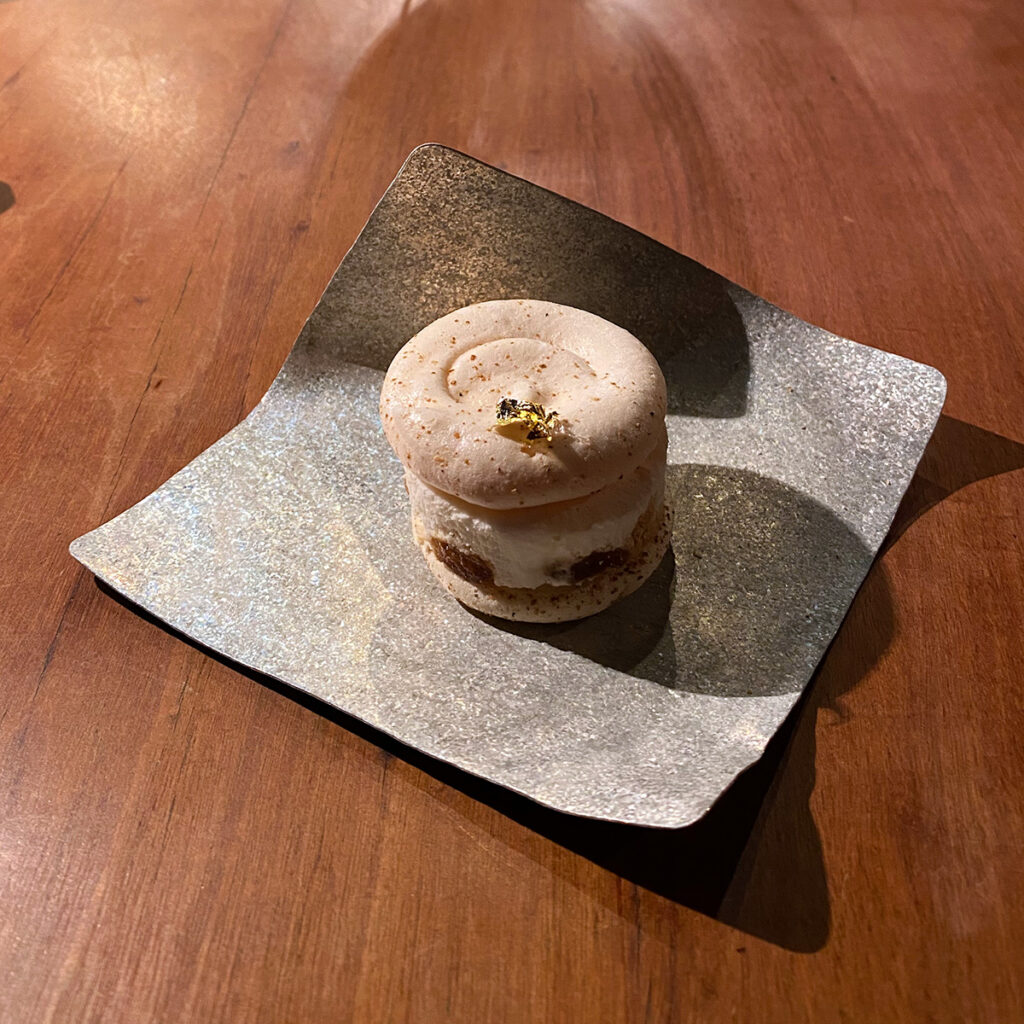
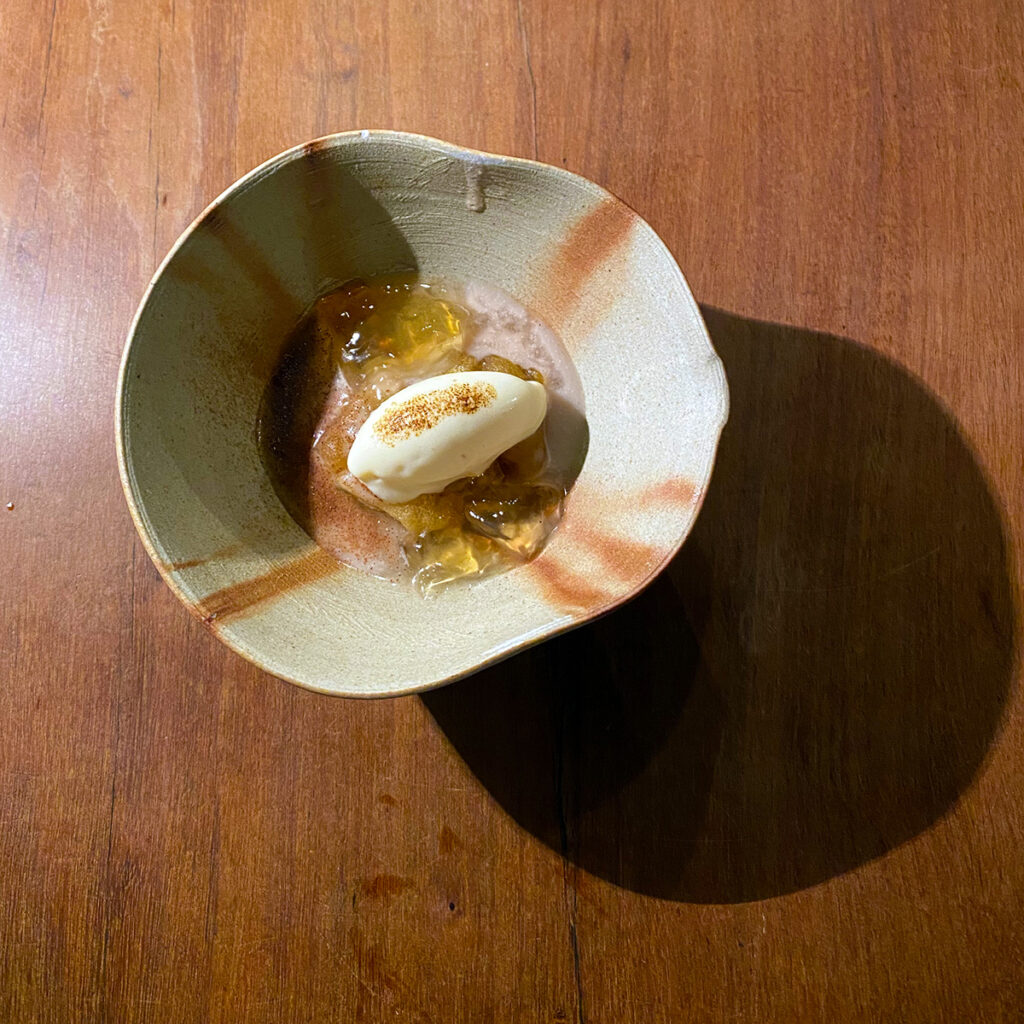
INTO THE BARCELONA NIGHT
We paid our bills, exchanged social media @’s, and walked in the direction of our hotels, none of us dressed properly for the bones-deep November cold. Hanne and Liam went opposite directions down La Rambla, while Analee and I continued into the maze of shopping streets, now deserted except for the teenagers without curfews. Barcelona loomed mysterious, our footsteps echoing off the closed shopfronts.
“Do you think you’ll come back?” Analee asked. “At least for the tuna belly.”
“Definitely.” We shared a smile. “Down the road, I’m sure I’ll launch one of the tours from Barcelona. But there’s a lot more of Spain to see.”
“And eat.”
“Sí.”
“What about you?” I asked her.
“We’re only three hours from Copenhagen. I might be here next month.” She grinned and shivered. “Or maybe when it’s warmer.”
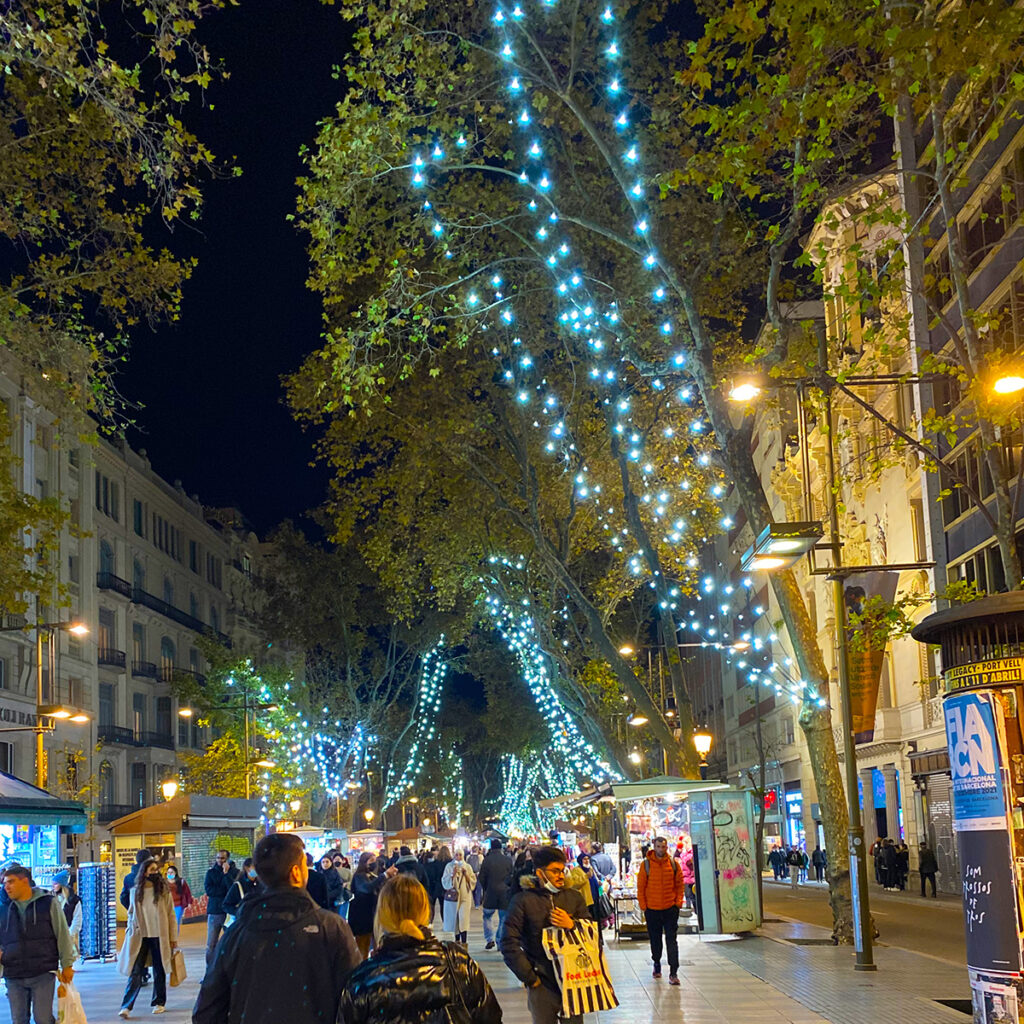
SEPARATING THE NEXTS FROM THE NOW
I put my arm around my new friend. Such chivalry! A few blocks later, we parted. I passed the Kimpton Vividora’s hotel key test—
“Who goes there? Friend or foe?”
“Friend.”
“Doth thou haveth thine key card?”
“Aye.”
—and entered the lobby, its warmth swirling around me, defeating the cold. I had a short night of packing and not much sleep ahead of me, before rising at a ridiculous hour for my taxi to the airport. I rode the elevator to my floor and began to pack for the flight home.
Traveling exacerbates life’s forward headspace. What’s next? What’s for lunch? When do we leave? When will we get there? But motorcycle travel mutes much of that, demanding you’re present, widening your vision, separating all those nexts with the now. Before I left California, in my mind I was already in Spain. And sadly, off the bike and in the hotel room, bags packed, I was already gone.

